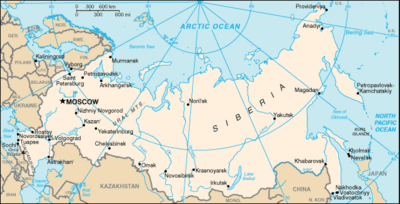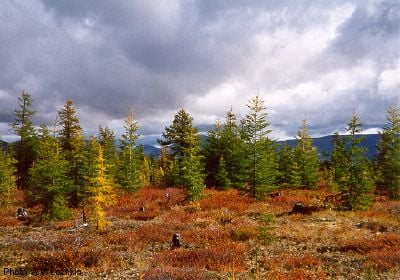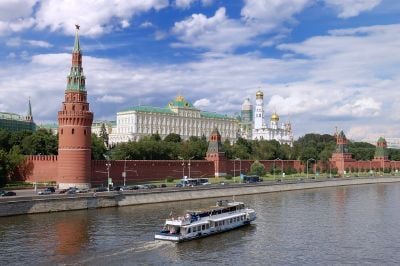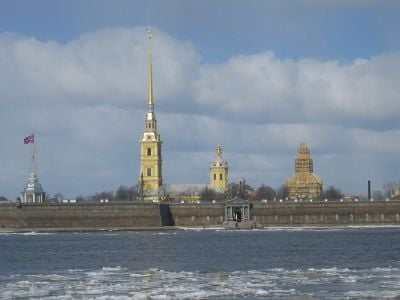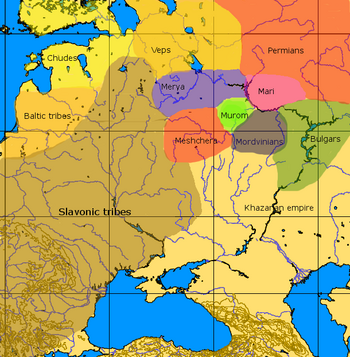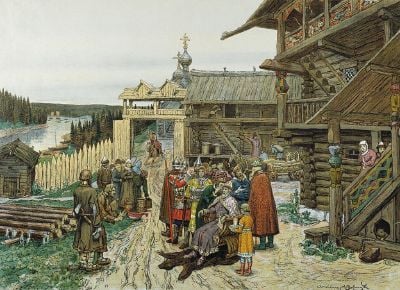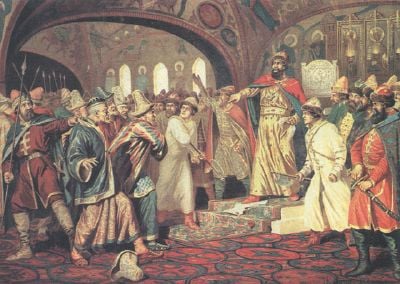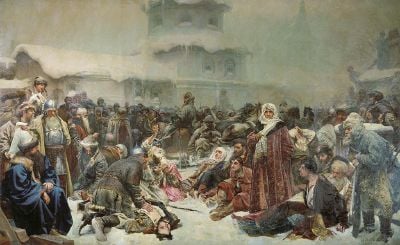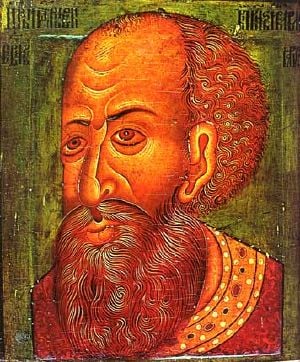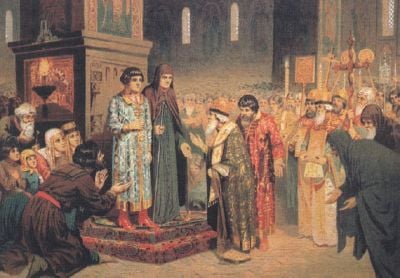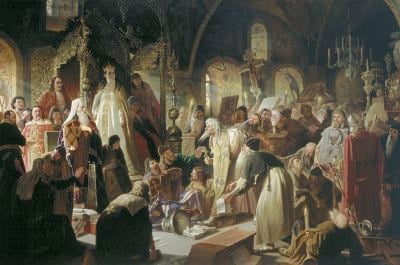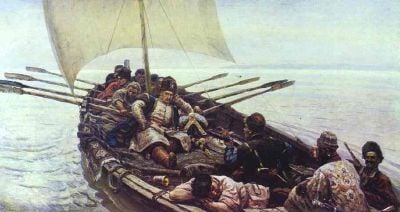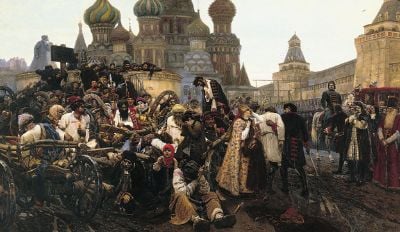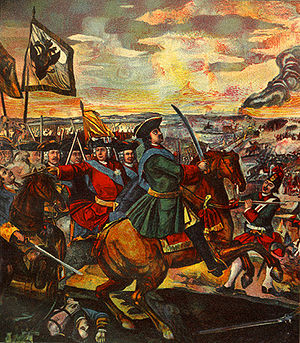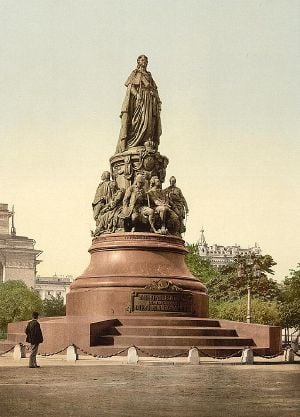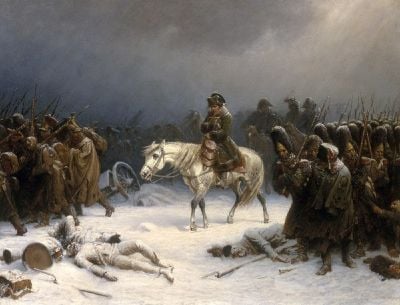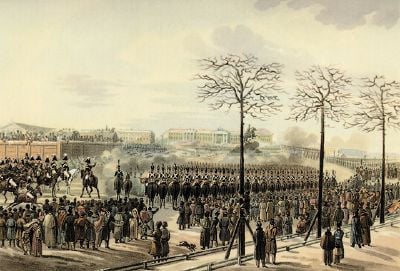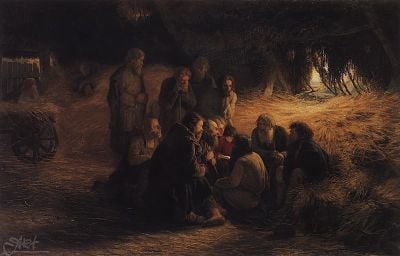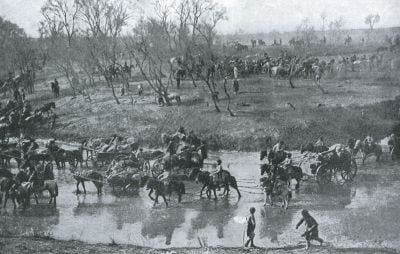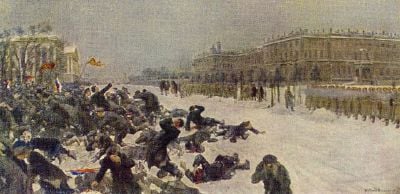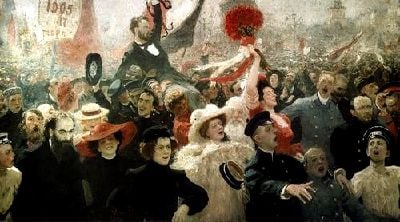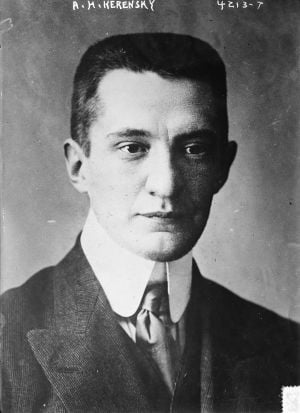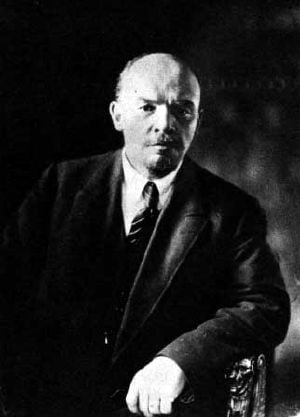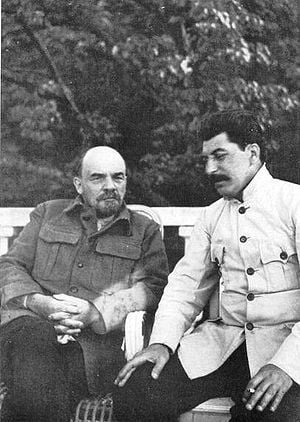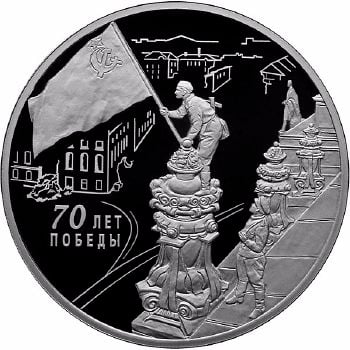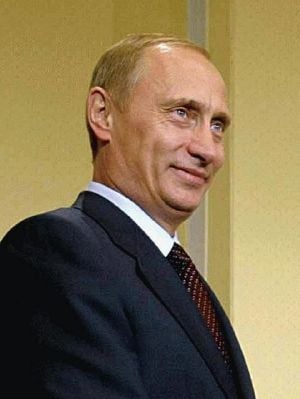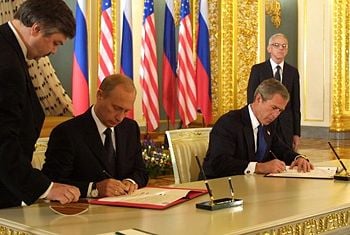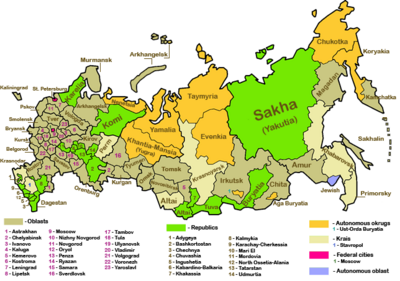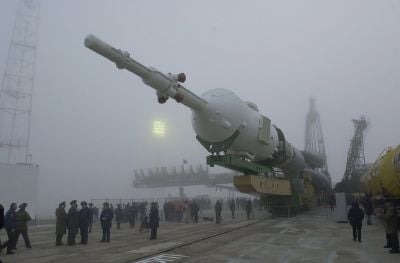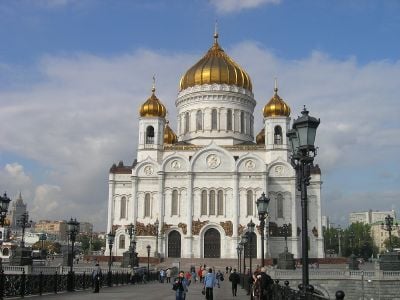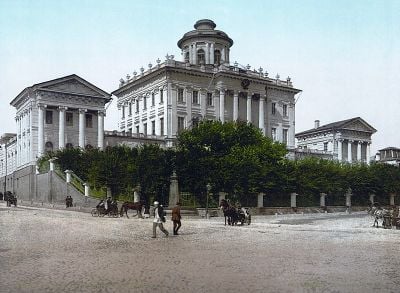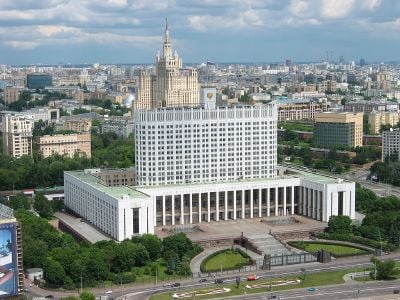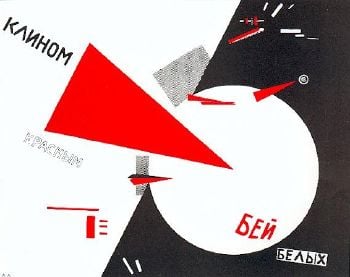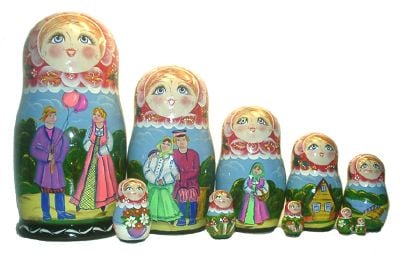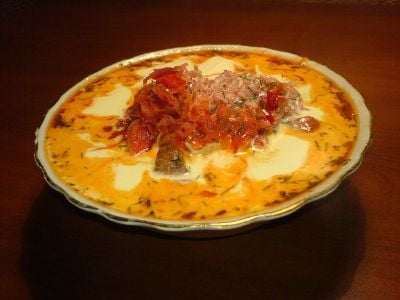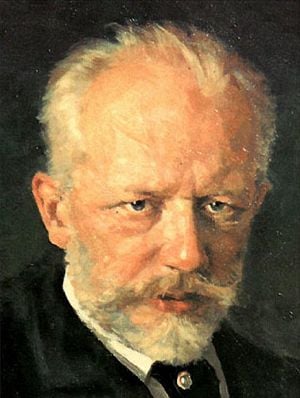| –†–ĺ—Ā—Ā–ł–Ļ—Ā–ļ–į—Ź –§–Ķ–ī–Ķ—Ä–į—Ü–ł—Ź Rossiyskaya Federatsiya Russian Federation |
||||||
|---|---|---|---|---|---|---|
|
||||||
| Anthem:¬†–ď–ĺ—Ā—É–ī–į—Ä—Ā—ā–≤–Ķ–Ĺ–Ĺ—č–Ļ –≥–ł–ľ–Ĺ –†–ĺ—Ā—Ā–ł–Ļ—Ā–ļ–ĺ–Ļ –§–Ķ–ī–Ķ—Ä–į—Ü–ł–ł (tr.: Gosudarstvenny gimn Rossiyskoy Federatsii) State Anthem of the Russian Federation |
||||||
| Capital (and largest city) | Moscow 55¬į45‚Ä≤N 37¬į37‚Ä≤E | |||||
| Official languages | Russian official throughout the country; 27 others co-official in various regions | |||||
| Ethnic groups (2010) | 81.0% Russians 3.7% Tatars 1.4% Ukrainians 1.2% Armenian 1.1% Bashkirs 1.0% Chuvashes 11.0% Others and Unspecified[1] |
|||||
| Demonym | Russian | |||||
| Government | Federal semi-presidential republic | |||||
|  -  | President | Vladimir Putin | ||||
|  -  | Prime Minister | Mikhail Mishustin | ||||
|  -  | Chairman of the Federation Council | Valentina Matviyenko | ||||
|  -  | Chairman of the State Duma | Vyacheslav Volodin | ||||
| Legislature | Federal Assembly | |||||
|  -  | Upper House | Federation Council | ||||
|  -  | Lower House | State Duma | ||||
| Formation | ||||||
|  -  | Rurik Dynasty | 862  | ||||
|  -  | Kievan Rus' | 882  | ||||
|  -  | Vladimir-Suzdal Rus' | 1169  | ||||
|  -  | Grand Duchy of Moscow | 1283  | ||||
|  -  | Tsardom of Russia | 16 January 1547  | ||||
|  -  | Russian Empire | 22 October 1721  | ||||
|  -  | Russian Soviet Federative Socialist Republic | 7 November 1917  | ||||
|  -  | Union of Soviet Socialist Republics | 10 December 1922  | ||||
|  -  | Russian Federation | 25 December 1991  | ||||
| Area | ||||||
|  -  | Total | 17,075,400 km² (1st) 6,592,800 sq mi  |
||||
|  -  | Water (%) | 13 (including swamps) | ||||
| Population | ||||||
|  -  | 2022 estimate | |||||
|  -  | Density | 8.4/km² (181st) 21.5/sq mi |
||||
| GDP (PPP) | 2022 estimate | |||||
|  -  | Total | |||||
|  -  | Per capita | |||||
| GDP (nominal) | 2022 estimate | |||||
|  -  | Total | |||||
|  -  | Per capita | |||||
| Gini (2020) | 36[4] (98th) | |||||
| Currency | Ruble (RUB) |
|||||
| Time zone | (UTC+3 to +12 (exc. +5)) | |||||
| Internet TLD | .ru, .su, .—Ä—Ą | |||||
| Calling code | [[++7]] | |||||
The Russian Federation (–†–ĺ—Ā—Ā–łŐĀ–Ļ—Ā–ļ–į—Ź –§–Ķ–ī–Ķ—Ä–įŐĀ—Ü–ł—Ź, Rossiyskaya Federatsiya), commonly known as Russia (Rossiya), is a transcontinental country extending over much of northern Eurasia (Asia and Europe).
The largest country in the world by land area, Russia has the world's ninth-largest population.
Formerly the Russian Soviet Federative Socialist Republic (RSFSR), a republic of the Union of Soviet Socialist Republics (USSR), Russia became the Russian Federation following the dissolution of the Soviet Union in December 1991. After the Soviet era, the area, population, and industrial production of the Soviet Union (then one of the world's two Cold War superpowers, the other being the United States) that were located in Russia passed on to the Russian Federation.
The Russian Federation emerged as a great power in the early twenty-first century, also considered to be an energy superpower. The country is considered the Soviet Union's successor state in diplomatic matters, and is a permanent member of the United Nations Security Council.
Geography
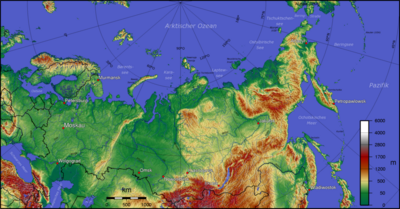
The Russian Federation stretches across much of the north of the supercontinent of Eurasia. Because of its size, Russia displays both monotony and diversity. As with its topography, its climates, vegetation, and soils span vast distances.
Russia shares land borders with the following countries (counter-clockwise from northwest to southeast): Norway, Finland, Estonia, Latvia, Lithuania, Poland, Belarus, Ukraine, Georgia, Azerbaijan, Kazakhstan, China, Mongolia, and North Korea. It is also close to the United States (the state of Alaska), Sweden, and Japan across relatively small stretches of water (the Bering Strait, the Baltic Sea, and La Pérouse Strait, respectively).
Russia has an extensive coastline of over 23,000 miles (37,000 kilometers) along the Arctic and Pacific Oceans, as well as the Baltic, Black and Caspian seas. Some smaller bodies of water are part of the open oceans; the Barents Sea, White Sea, Kara Sea, Laptev Sea and East Siberian Sea are part of the Arctic, whereas the Bering Sea, Sea of Okhotsk and the Sea of Japan belong to the Pacific Ocean. Major islands and archipelagos include Novaya Zemlya, the Franz Josef Land, the New Siberian Islands, Wrangel Island, the Kuril Islands and Sakhalin. The Diomede Islands (one controlled by Russia, the other by the United States) are just under two miles (three kilometers) apart, and Kunashir Island (controlled by Russia but claimed by Japan) is about 20 kilometers (12¬†mi) from Hokkaido. With access to three of the world's oceans -‚ÄĒthe Atlantic, Arctic, and Pacific‚ÄĒ- Russian fishing fleets are a major contributor to the economy.
With an area of 6,592,800 square miles (17,075,400 square kilometers), Russia is by far the largest country in the world, covering almost twice the total area of the next-largest country, Canada, and has significant mineral and energy resources.
Most of the land consists of broad plain with low hills west of Urals, and vast plains in Siberia. These plains are predominantly steppe to the south and heavily forested to the north, with tundra along the northern coast.
Mountain ranges are found along the southern borders, such as the Caucasus (containing Mount Elbrus, Russia's and Europe's highest point at 18,511 feet (5642 meters), and the Altai, and in the eastern parts, such as the Verkhoyansk Range or the volcanoes on Kamchatka. The more central Ural Mountains, a north-south range that form the primary divide between Europe and Asia, are also notable. The lowest point is the Caspian Sea, at 28 meters below sea level.
Russia has a largely continental climate because of its sheer size and compact configuration. Most of its land is more than 250 miles (400km) from the sea, and the center is 2386 miles (3840km) from the sea. In addition, Russia's mountain ranges, predominantly to the south and the east, block moderating temperatures from the Indian and Pacific Oceans, but European Russia and northern Siberia lack such topographic protection from the Arctic and North Atlantic Oceans. In much of the territory there are only two distinct seasons - winter and summer‚ÄĒspring and autumn are usually brief periods of change between extremely low and extremely high temperatures. The climates of both European and Asian Russia are continental except for the tundra and the extreme southeast. Winters vary from cool along Black Sea coast to frigid in Siberia, while summers vary from warm in the steppes to cool along Arctic coast. A small part of Black Sea coast around Sochi is considered in Russia to have subtropical climate.
Russia has thousands of rivers and inland bodies of water, providing it with one of the world's largest surface-water resources. The most prominent of Russia's bodies of fresh water is Lake Baikal, the world's deepest and most capacious freshwater lake. Lake Baikal alone contains over one fifth of the world's liquid fresh surface water. Truly unique on Earth, Baikal is home to more than 1700 species of plants and animals, two thirds of which can be found nowhere else in the world.
Of its 100,000 rivers, the Volga River is the most famous‚ÄĒnot only because it is the longest river in Europe but also because of its major role in Russian history. Major lakes include Lake Baikal, Lake Ladoga, and Lake Onega.
Russia has major deposits of petroleum, natural gas, coal, timber and many strategic minerals. Russia has the world's largest forest reserves, which supply lumber, pulp and paper, and raw material for woodworking industries. Formidable obstacles of climate, terrain, and distance hinder exploitation of natural resources. Permafrost over much of Siberia is a major impediment to development.
There is volcanic activity in the Kuril Islands, volcanoes and earthquakes on the Kamchatka Peninsula, and spring floods and summer/autumn forest fires throughout Siberia and parts of European Russia.
From north to south the East European Plain is clad sequentially in tundra, coniferous forest (taiga), mixed forest, broadleaf forest, grassland (steppe), and semidesert (fringing the Caspian Sea) reflecting the changes in climate. Siberia supports a similar sequence but lacks the mixed forest. Most of Siberia is taiga.
Environmental issues include air pollution from heavy industry, emissions of coal-fired electric plants, and transportation in major cities; industrial, municipal, and agricultural pollution of inland waterways and seacoasts; deforestation; soil erosion; soil contamination from improper application of agricultural chemicals; scattered areas of sometimes intense radioactive contamination; groundwater contamination from toxic waste; urban solid waste management; and abandoned stocks of obsolete pesticides.
Moscow is the capital and the country's economic, financial, educational, and transportation center. Located on the Moskva River in the Central Federal District, in the European part of Russia, Moscow's population constitutes about seven percent of the total population. Moscow is home to many scientific and educational institutions, as well as numerous sport facilities. It possesses a complex transport system that includes the world's busiest rapid transit system, which is famous for its architecture. Moscow also hosted the 1980 Summer Olympics.
Saint Petersburg, Russia's second major city, is located in the Northwestern Federal District of Russia on the Neva River at the east end of the Gulf of Finland on the Baltic Sea. Saint Petersburg's informal name, Piter is based on how Peter the Great was called by foreigners. The city's other names were Petrograd and Leningrad. Founded by Tsar Peter the Great in 1703 as a "window to Europe" it was capital of the Russian Empire for more than two hundred years (1712-1728, 1732-1918). Saint Petersburg ceased being the capital in 1918 after the Russian Revolution of 1917.
There are 1108 cities and towns in Russia, according to the 2002 Russian Census.
History
Pre-Slavic inhabitants
The vast steppes of Southern Russia were home to disunited tribes, such as Proto-Indo-Europeans and Scythians. Astonishing remnants of these long-gone civilizations were discovered in the course of the twentieth century at Ipatovo, and Pazyryk. In the latter part of the eighth century B.C.E., Greek merchants brought classical civilization to the trade emporiums in Tanais and Phanagoria.
Between the third and sixth centuries C.E., the Bosporan Kingdom, a Hellenistic polity which succeeded the Greek colonies, was overwhelmed by successive waves of nomadic invasions, led by warlike tribes which would often move on to Europe, as was the case with Huns and Turkish Avars. A Turkic people, the Khazars, reigned over the lower Volga basin steppes between the Caspian and Black Seas through the eighth century. Noted for their laws, tolerance, and cosmopolitanism, the Khazars were the main commercial link between the Baltic and the Muslim Abbasid empire centered in Baghdad. They were important allies of the Byzantine Empire, and waged a series of successful wars against the Arab Caliphates. In the eighth century, the Khazars embraced Judaism.
Early East Slavs
The ancestors of the Russians were the Slavic tribes, whose original home is thought by some scholars to have been the wooded areas of the Pripet Marshes. Moving into the lands vacated by the migrating Germanic tribes, the Early East Slavs gradually settled Western Russia in two waves: one moving from Kiev toward present-day Suzdal and Murom, and another from Polotsk toward Novgorod and Rostov. From the seventh century onwards, the East Slavs constituted the bulk of the population in Western Russia and slowly but peacefully assimilated the native Finno-Ugric tribes, such as the Merya, the Muromians, and the Meshchera.
Kievan Rus'
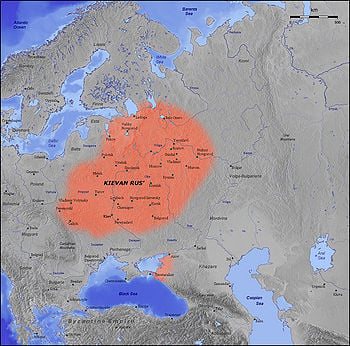
Scandinavian Norsemen, called "Vikings" in Western Europe and "Varangians" in the East, combined piracy and trade in their roamings over much of Northern Europe. In the mid-ninth century, they began to venture along the waterways from the eastern Baltic to the Black and Caspian Seas. According to the earliest chronicle of Kievan Rus', a Varangian named Rurik was elected ruler of Novgorod in about 860, before his successors moved south and extended their authority to Kiev, which had been previously dominated by the Khazars.
Thus, the first East Slavic state, Kievan Rus', emerged in the ninth century along the Dnieper River valley. A coordinated group of princely states with a common interest in maintaining trade along the river routes, Kievan Rus' controlled the trade route for furs, wax, and slaves between Scandinavia and the Byzantine Empire along the Volkhov and Dnieper rivers.
The name "Russia," together with the Finnish Ruotsi and Estonian Rootsi, are found by some scholars to be related to Roslagen. The etymology of Rus and its derivatives are debated, and other schools of thought connect the name with Slavic or Iranic roots.
By the end of the tenth century, the Norse minority had merged with the Slavic population, particularly among the aristocracy, which also absorbed Greek Christian influences in the course of the multiple campaigns to loot Tsargrad, or Constantinople. One such campaign claimed the life of the foremost Slavic druzhina leader, Svyatoslav I, who was renowned for having crushed the power of the Khazars on the Volga. While the fortunes of the Byzantine Empire had been ebbing, its culture was a continuous influence on the development of Russia in its formative centuries.
Kievan Rus' is important for its introduction of a Slavic variant of the Eastern Orthodox religion, dramatically deepening a synthesis of Byzantine and Slavic cultures that defined Russian culture for the next thousand years. The region adopted Christianity in 988 by the official act of public baptism of Kiev inhabitants by Prince Vladimir I. Some years later the first code of laws, Russkaya Pravda, was introduced. From the onset the Kievan princes followed the Byzantine example and kept the Church dependent on them, even for its revenues, so that the Russian Church and state were always closely linked.
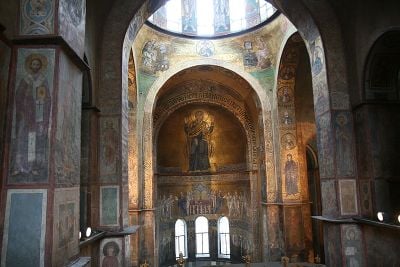
By the eleventh century, particularly during the reign of Yaroslav the Wise, Kievan Rus' could boast an economy and achievements in architecture and literature superior to those that then existed in the western part of the continent. Compared with the languages of European Christendom, the Russian language was little influenced by the Greek and Latin of early Christian writings. This was due to the fact that Church Slavonic was used directly in liturgy.
Nomadic Turkic people Kipchaks replaced the earlier Pechenegs as a dominant force in the south steppe regions neighboring to Rus' at the end of eleventh century and founded a nomadic state in the steppes along the Black Sea. Repelling their regular attacks, especially on Kiev, which was just one day riding away from the steppe, was a heavy burden for the southern areas of Rus'. The nomadic incursions caused a massive influx of Slavic population to the safer, heavily forested regions of the north.
Kievan Rus' ultimately disintegrated as a state because of the armed struggles among members of its princely family. Kiev's dominance waned, to the benefit of Vladimir-Suzdal in the north-east, Novgorod in the north, and Halych-Volhynia in the south-west. Conquest by the Mongol Golden Horde in the thirteenth century was the final blow. Kiev was destroyed. Halych-Volhynia would eventually be absorbed into the Polish-Lithuanian Commonwealth, while the Mongol-dominated Vladimir-Suzdal and independent Novgorod Republic, two regions on the periphery of Kiev, would establish the basis for the modern Russian nation.
Mongol invasion
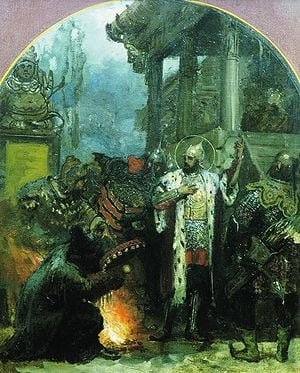
The invading Mongols accelerated the fragmentation of the Ancient Rus'. In 1223, the disunited southern princes faced a Mongol raiding party at the Kalka River and were soundly defeated. In 1237-1238 the Mongols burned down the city of Vladimir(February 4, 1238) and other major cities of northeast Russia, routed the Russians at the Sit' River, and then moved west into Poland and Hungary. By then they had conquered most Russian principalities. Only the Novgorod Republic escaped occupation and continued to flourish in the orbit of the Hanseatic League.
The impact of the Mongol invasion on the territories of Kievan Rus' was uneven. The advanced city culture was almost completely destroyed. As older centers such as Kiev and Vladimir never recovered from the devastation of the initial attack, the new cities of Moscow, began to compete for hegemony in the Mongol-dominated Russia. Although a Russian army defeated the Golden Horde at Kulikovo in 1380, Tatar domination of the Russian-inhabited territories, along with demands of tribute from Russian princes, continued until about 1480.
Russo-Tatar relations
After the fall of the Khazars in the tenth century, the middle Volga came to be dominated by the mercantile state of Volga Bulgaria, the last vestige of Greater Bulgaria centered at Phanagoria. In the tenth century, the Turkic population of Volga Bulgaria converted to Islam, which facilitated its trade with the Middle East and Central Asia. In the wake of the Mongol invasions of the 1230s, Volga Bulgaria was absorbed by the Golden Horde and its population evolved into the modern Chuvashes and Kazan Tatars.
The Mongols held Russia and Volga Bulgaria in sway from their western capital at Sarai, which with a population of 600,000, was one of the largest cities of the medieval world. The princes of southern and eastern Russia had to pay tribute to the Mongols of the Golden Horde, commonly called Tatars, and in return they received charters authorizing them to act as deputies to the khans. The princes were allowed considerable freedom to rule as they wished.
To the Orthodox Church and most princes, the fanatical Northern Crusaders seemed a greater threat to the Russian way of life than the Mongols. In the mid-thirteenth century, Alexander Nevsky, elected prince of Novgorod, acquired heroic status as the result of victories over the Teutonic Knights and the Swedes. Alexander obtained Mongol protection and assistance in fighting invaders from the west who, hoping to profit from the Russian collapse since the Mongol invasions, tried to grab territory and convert the Russians to Roman Catholicism.
The Mongols left their impact on the Russians in such areas as military tactics and transportation. Under Mongol occupation, Russia also developed its postal road network, census, fiscal system, and military organization. Eastern influence remained strong well until the seventeenth century, when Russian rulers made a conscious effort to Westernize their country.
The rise of Moscow
Daniel Aleksandrovich (1261-1303), the youngest son of Alexander Nevsky, founded the principality of Moscow (known in the western tradition as Muscovy), which eventually expelled the Tatars from Russia. Well-situated in the central river system of Russia and surrounded by protective forests and marshes, Moscow was at first only a vassal of Vladimir, but soon it absorbed its parent state. A major factor in the ascendancy of Moscow was the cooperation of its rulers with the Mongol overlords, who granted them the title of Grand Prince of Moscow and made them agents for collecting the Tatar tribute from the Russian principalities. The principality's prestige was further enhanced when it became the center of the Russian Orthodox Church. Its head, the metropolitan, fled from Kiev to Vladimir in 1299 and a few years later established the permanent headquarters of the Church in Moscow.
By the middle of the fourteenth century, the power of the Mongols was declining, and the Grand Princes felt able to openly oppose the Mongol yoke. In 1380, at Kulikovo on the Don River, the Mongols were defeated, and although this hard-fought victory did not end Tatar rule of Russia, it did bring great fame to the Grand Prince. Moscow's leadership in Russia was now firmly based and by the middle of the fourteenth century its territory had greatly expanded through purchase, war, and marriage.
Ivan III, the Great
In the fifteenth century, the grand princes of Moscow continued gathering Russian lands to increase the population and wealth under their rule. The most successful practitioner of this process was Ivan the Great, (1462‚Äď1505), who laid the foundations for a Russian national state. Ivan competed with his powerful northwestern rival, the Grand Duchy of Lithuania, for control over some of the semi-independent Upper Principalities in the upper Dnieper and Oka River basins.
Through the defections of some princes, border skirmishes, and a long war with the Novgorod Republic, Ivan III was able to annex Novgorod and Tver. As a result, the Grand Duchy of Moscow tripled in size under his rule. During his conflict with Pskov, a monk named Filofei (Philotheus of Pskov) composed a letter to Ivan III, with the prophecy that the latter's kingdom would be the Third Rome. The Fall of Constantinople and the death of the last Greek Orthodox Christian emperor contributed to this new idea of Moscow as the "New Rome" and the seat of Orthodox Christianity.
A contemporary of the Tudors and other "new monarchs" in Western Europe, Ivan proclaimed his absolute sovereignty over all Russian princes and nobles. Refusing further tribute to the Tatars, Ivan initiated a series of attacks that opened the way for the complete defeat of the declining Golden Horde, now divided into several khanates and hordes. Ivan and his successors sought to protect the southern boundaries of their domain against attacks of the Crimean Tatars and other hordes. To achieve this aim, they sponsored the construction of the Great Abatis Belt and granted manors to nobles, who were obliged to serve in the military. The manor system provided a basis for an emerging horse army.
In this way, internal consolidation accompanied outward expansion of the state. By the sixteenth century, the rulers of Moscow considered the entire Russian territory their collective property. Various semi-independent princes still claimed specific territories, but Ivan III forced the lesser princes to acknowledge the grand prince of Moscow and his descendants as unquestioned rulers with control over military, judicial, and foreign affairs. Gradually, the Russian ruler emerged as a powerful, autocratic ruler, a tsar. The first Russian ruler to officially crown himself "Tsar" was Ivan IV.
Ivan IV, the Terrible
The development of the Tsar's autocratic powers reached a peak during the reign (1547‚Äď1584) of Ivan the Terrible. He strengthened the position of the monarch to an unprecedented degree, as he ruthlessly subordinated the nobles to his will, exiling or executing many on the slightest provocation. Nevertheless, Ivan is often seen a farsighted statesman who reformed Russia as he promulgated a new code of laws, established the first Russian feudal representative body, curbed the influence of clergy, and introduced the local self-management in rural regions.
Although his long Livonian War for the control of the Baltic coast and the access to sea trade ultimately proved a costly failure, Ivan managed to annex the Khanates of Kazan, Astrakhan, and Siberia. These conquests complicated the migration of the aggressive nomadic hordes from Asia to Europe through Volga and Ural. Through these conquests, Russia acquired a significant Muslim Tatar population and emerged as a multi-ethnic and multi-confessional state. Also around this period, the mercantile Stroganov family established a firm foothold at the Urals and recruited Russian Cossacks to colonize Siberia.
In the later part of his reign, Ivan divided his realm in two. In the zone known as the oprichnina, Ivan's followers carried out a series of bloody purges of the feudal aristocracy (which he suspected of treachery after the betrayal of prince Kurbsky), culminating in the Massacre of Novgorod (1570). This combined with the military losses, epidemics and poor harvests so weakened Muscovy that the Crimean Tatars were able to sack central Russian regions and burn down Moscow in 1571. At the end of Ivan IV's reign the Polish-Lithuanian and Swedish armies carried out the powerful intervention into Russia, devastating its northern and northwest regions.
Time of troubles
The death of Ivan's childless son Feodor was followed by a period of civil wars and foreign intervention known as the "Time of Troubles" (1606‚Äď1613). An extremely cold summer (1601-1603) destroyed crops, leading to famine and increased social disorganization. Boris Godunov's reign ended in chaos, with civil war, foreign intrusion, devastation of many cities, and depopulation of the rural regions. The internal chaos attracted several waves of interventions by the Polish-Lithuanian Commonwealth. The invaders reached Moscow and installed, first, the impostor False Dmitriy I and, later, a Polish prince Wladyslaw IV Vasa on the Russian throne. The Moscow population revolted but the riots were brutally suppressed and the city was set on fire.
The crisis provoked the patriotic national uprising against the invasion and in the autumn of 1612, the volunteer army led by the merchant Kuzma Minin and prince Dmitry Pozharsky, expelled foreign forces from the capital. The Russian statehood survived the "Time of Troubles" and the rule of weak or corrupt Tsars due to the strength of the government's central bureaucracy. Government functionaries continued to serve, regardless of the ruler's legitimacy or the faction controlling the throne.
Early Romanovs
In February, 1613, with the chaos ended and the Poles expelled from Moscow, a national assembly composed of representatives from 50 cities and even some peasants, elected Michael Romanov, the young son of Patriarch Filaret, to the throne. The Romanov dynasty ruled Russia until 1917.
The immediate task of the new dynasty was to restore peace. Fortunately for Moscow, its major enemies, the Polish-Lithuanian Commonwealth and Sweden, were engaged in a bitter conflict with each other, which provided Russia the opportunity to make peace with Sweden in 1617 and to sign a truce with the Polish-Lithuanian Commonwealth in 1619. Recovery of lost territories began in the mid-seventeenth century, when the Khmelnitsky Uprising in Ukraine against Polish rule brought about the Treaty of Pereyaslav. According to the treaty, Russia granted protection to the Cossacks state in the Left-bank Ukraine, formerly under the Polish control. This triggered a prolonged Russo-Polish War which ended with the Treaty of Andrusovo in 1667 in which Poland accepted the loss of Left-bank Ukraine, Kiev and Smolensk.
Rather than risk their estates in continued civil war, the great nobles cooperated with the first Romanovs, enabling them to finish the work of bureaucratic centralization. Thus, the state required service from both the old and the new nobility, primarily in the military. In return the tsars allowed the boyars to complete the process of enserfing the peasants.
Peasant rebellions
In the preceding century, the state had gradually curtailed peasants' rights to move from one landlord to another. With the state now fully sanctioning serfdom, runaway peasants became state fugitives, and the power of the landlords over the peasants "attached" to their land had become almost complete. Together the state and the nobles placed the overwhelming burden of taxation on the peasants, whose rate was 100 times greater in the mid-seventeenth century than it had been a century earlier. In addition, middle-class urban tradesmen and craftsmen were assessed for taxes, and, like the serfs, they were forbidden to change residence. All segments of the population were subject to military levy and to special taxes.
Under such circumstances, peasant disorders were endemic; even the citizens of Moscow revolted against the Romanovs during the Salt Riot (1648), Copper Riot (1662), and the Moscow Uprising (1682). By far the greatest peasant uprising in seventeenth century Europe erupted in 1667. As the free settlers of South Russia, the Cossacks, reacted against the growing centralization of the state, serfs escaped from their landlords and joined the rebels. The Cossack leader Stenka Razin led his followers up the Volga River, incited peasant uprisings and replaced local governments with Cossack rule. The tsar's army finally crushed his forces in 1670; a year later Stenka was captured and beheaded. Yet, less than half a century later, the strains of military expeditions produced another revolt in Astrakhan, which was ultimately subdued.
Peter the Great
Peter the Great (1672‚Äď1725) consolidated autocracy in Russia and played a major role in bringing his country into the European state system. From its modest beginnings in the fourteenth century principality of Moscow, Russia had become the largest state in the world by Peter's time. Three times the size of continental Europe, it spanned the Eurasian landmass from the Baltic Sea to the Pacific Ocean. Much of its expansion had taken place in the seventeenth century, culminating in the first Russian settlement of the Pacific in the mid-seventeenth century, the reconquest of Kiev, and the pacification of the Siberian tribes. However, this vast land had a population of only 14 million. Grain yields trailed behind those of agriculture in the West, due partly to heavier climatic conditions, in particular long cold winters and a short vegetative period compelling almost the entire population to farm. Only a small fraction of the population lived in urban areas. Russia remained isolated from sea trade, its internal trade communications and many manufactures were dependent on the seasonal changes.
Peter's first military efforts were directed against the Ottoman Turks. His aim was to establish a Russian foothold on the Black Sea by taking the town of Azov. His attention then turned to the north. Peter still lacked a secure northern seaport except at Archangel on the White Sea, whose harbor was frozen nine months a year. Access to the Baltic was blocked by Sweden, whose territory enclosed it on three sides. Peter's ambitions for a "window to the sea" led him in 1699 to make a secret alliance with the Polish-Lithuanian Commonwealth and Denmark against Sweden resulting in the Great Northern War. The war ended in 1721 when an exhausted Sweden sued for peace with Russia. Peter acquired four provinces situated south and east of the Gulf of Finland, thus securing his coveted access to the sea. There, in 1703, he had already founded the city that was to become Russia's new capital, St. Petersburg, as a "window opened upon Europe" to replace Moscow, long Russia's cultural center. Russian intervention in the Commonwealth marked, with the Silent Sejm, the beginning of a 200-year domination of that region by the Russian Empire. In celebration of his conquests, Peter assumed the title of emperor as well as tsar, and Muscovite Russia officially became the Russian Empire in 1721.
Peter reorganized his government on the latest Western models, molding Russia into an absolutist state. He replaced the old boyar Duma (council of nobles) with a nine-member senate, in effect a supreme council of state. The countryside was also divided into new provinces and districts. Peter told the senate that its mission was to collect taxes, which tripled over the course of his reign. As part of the government reform, the Orthodox Church was partially incorporated into the country's administrative structure, in effect making it a tool of the state. Peter abolished the patriarchate and replaced it with a collective body, the Holy Synod, led by a lay government official. Meanwhile, all vestiges of local self-government were removed, and Peter continued and intensified his predecessors' requirement of state service for all nobles.
Peter died in 1725, leaving an unsettled succession and an exhausted realm. His reign raised questions about Russia's backwardness, and its relationship to the West. Nevertheless, he had laid the foundations of a modern state in Russia.
Catherine the Great
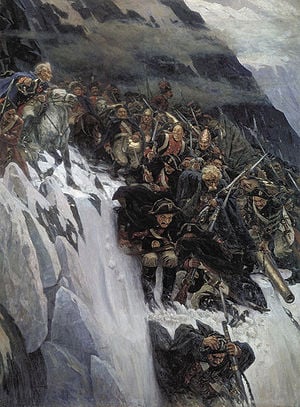
Nearly 40 years were to pass before a comparably ambitious and ruthless ruler appeared on the Russian throne. Catherine the Great (Russian: Yekaterina II) was a German princess who married the German heir to the Russian crown. Finding him incompetent, Catherine tacitly consented to his murder. It was announced that he had died of "apoplexy," and in 1762 she became ruler.
Catherine contributed to the resurgence of the Russian nobility that began after the death of Peter the Great. Mandatory state service was abolished, and Catherine delighted the nobles further by turning over most government functions in the provinces to them.
Catherine the Great extended Russian political control over the Polish-Lithuanian Commonwealth, although the cost of her campaigns, on top of the oppressive social system that required serfs to spend almost all of their time laboring on the lords' land, provoked a peasant uprising in 1773, after Catherine legalized the selling of serfs separate from land. Inspired by another Cossack named Pugachev, with the emphatic cry of "Hang all the landlords!" the rebels threatened to take Moscow before they were ruthlessly suppressed. Catherine had Pugachev drawn and quartered in Red Square, but the specter of revolution continued to haunt her and her successors.
Catherine successfully waged war against the decaying Ottoman Empire and advanced Russia's southern boundary to the Black Sea. Then, by allying with the rulers of Austria and Prussia, she incorporated the territories of the Polish-Lithuanian Commonwealth, where after a century of Russian rule, the non-Catholic mainly Orthodox population prevailed during the Partitions of Poland, pushing the Russian frontier westward into Central Europe. By the time of her death in 1796, Catherine's expansionist policy had turned Russia into a major European power. This continued with Alexander I's wresting of Finland from the weakened kingdom of Sweden in 1809 and of Bessarabia from the Ottomans in 1812.
Napoleon made a major misstep when he declared war on Russia after a dispute with Tsar Alexander I and launched an invasion of Russia in 1812. The campaign was a catastrophe. In the bitterly cold Russian weather, thousands of French troops were ambushed and killed by peasant guerrilla fighters. As Napoleon's forces retreated, the Russian troops pursued them into Central and Western Europe and to the gates of Paris. After Russia and its allies defeated Napoleon, Alexander became known as the 'savior of Europe,' and he presided over the redrawing of the map of Europe at the Congress of Vienna (1815), which made Alexander the monarch of Congress Poland.
Although the Russian Empire would play a leading political role in the next century, secured by its defeat of Napoleonic France, its retention of serfdom precluded economic progress of any significant degree. As West European economic growth accelerated during the Industrial Revolution, sea trade and exploitation of colonies which had begun in the second half of the eighteenth century, Russia began to lag ever farther behind.
The Decembrist Revolt
Russia's great power status obscured the inefficiency of its government, the isolation of its people, and its economic backwardness. Following the defeat of Napoleon, Alexander I was willing to discuss constitutional reforms, and though a few were introduced, no thoroughgoing changes were attempted.
The tsar was succeeded by his younger brother, Nicholas I (1825‚Äď1855), who at the onset of his reign was confronted with an uprising. The background of this revolt lay in the Napoleonic Wars, when a number of well-educated Russian officers traveled in Europe in the course of the military campaigns, where their exposure to the liberalism of Western Europe encouraged them to seek change upon their return to autocratic Russia. The result was the Decembrist Revolt (December 1825), the work of a small circle of liberal nobles and army officers who wanted to install Nicholas' brother as a constitutional monarch. But the revolt was easily crushed, leading Nicholas to turn away from the Westernization program begun by Peter the Great and champion the maxim "Autocracy, Orthodoxy, and Nationality."
In the early decades of the nineteenth century, Russia expanded into Transcaucasia and the highlands of the North Caucasus. In 1831 Nicholas crushed a major uprising in Congress Poland; it would be followed by another large-scale Polish and Lithuanian revolt in 1863.
Ideological schisms
In this setting Mikhail Bakunin would emerge as the father of anarchism. He left Russia in 1842 for Western Europe, where he became active in the socialist movement. After participating in the May Uprising in Dresden of 1849, he was imprisoned and shipped to Siberia, but eventually escaped and made his way back to Europe. There he practically joined forces with Karl Marx, despite significant ideological and tactical differences. Alternative social doctrines were elaborated by such Russian radicals as Alexander Herzen and Peter Kropotkin.
The question of Russia's direction had been gaining steam ever since Peter the Great's program of Westernization. Some favored imitating Europe while others renounced the West and called for a return to the traditions of the past. The latter path was championed by Slavophiles, who heaped scorn on the "decadent" West. The Slavophiles were opponents of bureaucracy, preferred the collectivism of the medieval Russian village community, to the individualism of the West.
Alexander II and the abolition of serfdom
Tsar Nicholas died with his philosophy in dispute. One year earlier, Russia had become involved in the Crimean War, a conflict fought primarily in the Crimean peninsula. Since playing a major role in the defeat of Napoleon, Russia had been regarded as militarily invincible, but, once pitted against a coalition of the great powers of Europe, the reverses it suffered on land and sea exposed the decay and weakness of Tsar Nicholas' regime.
When Alexander II came to the throne in 1855, desire for reform was widespread. A growing humanitarian movement, which in later years has been likened to that of the abolitionists in the United States before the American Civil War, attacked serfdom. In 1859, there were 23 million serfs (total population of Russia 67.1 million) living under conditions frequently worse than those of the peasants of Western Europe on sixteenth century manors. Alexander II decided to abolish serfdom from above rather than wait for it to be abolished from below through revolution.
The emancipation of the serfs in 1861 was the single most important event in nineteenth century Russian history. It was the beginning of the end for the landed aristocracy's monopoly of power. Emancipation brought a supply of free labor to the cities, industry was stimulated, and the middle class grew in number and influence. However, instead of receiving their lands as a gift, the freed peasants had to pay a special tax for what amounted to their lifetime to the government, which in turn paid the landlords a generous price for the land that they had lost. In numerous instances the peasants wound up with the poorest land. All the land turned over to the peasants was owned collectively by the mir, the village community, which divided the land among the peasants and supervised the various holdings. Although serfdom was abolished, since its abolition was achieved on terms unfavorable to the peasants, revolutionary tensions were not abated, despite Alexander II's intentions.
In the late 1870s Russia and the Ottoman Empire again clashed in the Balkans. The Russo-Turkish War (1877‚Äď1878) was popular among Russians, who supported the independence of their fellow Orthodox Slavs, the Serbs and the Bulgarians. However, the war increased tension with Austria-Hungary, which also had ambitions in the region. During this period Russia expanded its empire into Central Asia, which was rich in raw materials, conquering the khanates of Kokand, Bokhara and Khiva, as well as the Trans-Caspian region.
Nihilism
In the 1860s a movement known as Nihilism developed in Russia. For some time many Russian liberals had been dissatisfied by what they regarded as the empty discussions of the intelligentsia. The Nihilists questioned all old values and shocked the Russian establishment. The Nihilists first attempted to convert the aristocracy to the cause of reform. Failing there, they turned to the peasants. Their "go to the people" campaign became known as the Narodnik movement. While the Narodnik movement was gaining momentum, the government quickly moved to extirpate it. In response to the growing reaction of the government, a radical branch of the Narodniks advocated and practiced terrorism. One after another, prominent officials were shot or killed by bombs. Finally, after several attempts, Alexander II was assassinated in 1881, on the very day he had approved a proposal to call a representative assembly to consider new reforms in addition to the abolition of serfdom designed to ameliorate revolutionary demands.
Autocracy and reaction under Alexander III
Unlike his father, the new tsar Alexander III (1881‚Äď1894) was throughout his reign a staunch reactionary who revived the maxim of "Orthodoxy, Autocracy, and National Character." A committed Slavophile, Alexander III believed that Russia could be saved from chaos only by shutting itself off from the subversive influences of Western Europe. In his reign Russia concluded the union with republican France to contain the growing power of Germany, completed the conquest of Central Asia, and exacted important territorial and commercial concessions from China.
The tsar's most influential adviser was Konstantin Pobedonostsev, tutor to Alexander III and his son Nicholas, and procurator of the Holy Synod from 1880 to 1895. He taught his royal pupils to fear freedom of speech and freedom of the press and to hate democracy, constitutions, and the parliamentary system. Under Pobedonostsev, revolutionaries were hunted down and a policy of Russification was carried out throughout the empire.
New revolutionary movements
Alexander was succeeded by his son Nicholas II (1894‚Äď1917). The Industrial Revolution, which began to exert a significant influence in Russia, was meanwhile creating forces that would finally overthrow the tsar. Politically, these opposition forces organized into three competing parties: The liberal elements among the industrial capitalists and nobility, who believed in peaceful social reform and a constitutional monarchy, founded the Constitutional Democratic party or Kadets in 1905. Followers of the Narodnik tradition established the Socialist-Revolutionary Party or Esers in 1901, advocating the distribution of land among those who actually worked it‚ÄĒthe peasants. A third and more radical group founded the Russian Social Democratic Labour Party or RDSLP in 1898; this party was the primary exponent of Marxism in Russia. Gathering their support from the radical intellectuals and the urban working class, they advocated complete social, economic and political revolution.
Bolsheviks and Mensheviks
In 1903 the RDSLP split into two wings: the radical Bolsheviks, led by Vladimir Lenin (1870-1924), and the relatively moderate Mensheviks, led by Lenin's former friend Yuli Martov. The Mensheviks believed that Russian socialism would grow gradually and peacefully and that the tsar’s regime should be succeeded by a democratic republic in which the socialists would cooperate with the liberal bourgeois parties. The Bolsheviks, under Lenin, advocated the formation of a small elite of professional revolutionists, subject to strong party discipline, to act as the vanguard of the proletariat in order to seize power by force.
The disastrous performance of the Russian armed forces in the Russo-Japanese War was a blow to the Russian State and increased the potential for unrest. In January 1905, an incident known as "Bloody Sunday (1905)" occurred when Father Gapon led an enormous crowd to the Winter Palace in Saint Petersburg to present a petition to the tsar. When the procession reached the palace, Cossacks opened fire on the crowd, killing hundreds. The Russian masses were so aroused over the massacre that a general strike was declared demanding a democratic republic. This marked the beginning of the Russian Revolution of 1905. Soviets (councils of workers) appeared in most cities to direct revolutionary activity.
National duma created
In October 1905, Nicholas reluctantly issued the famous October Manifesto, which conceded the creation of a national duma (legislature) to be called without delay. The right to vote was extended, and no law was to go into force without confirmation by the Duma. The moderate groups were satisfied; but the socialists rejected the concessions as insufficient and tried to organize new strikes. By the end of 1905, there was disunity among the reformers, and the tsar's position was strengthened for the time being.
World War I
Bound by treaty, Tsar Nicholas II and his subjects entered World War I to defend Serbia. At the opening of hostilities in August of 1914, the Russians took the offensive against both Germany and Austria-Hungary in support of France.
Later, military failures and bureaucratic ineptitude soon turned large segments of the population against the government. Control of the Baltic Sea by the German fleet, and of the Black Sea by combined German and Ottoman forces prevented Russia from importing supplies and exporting goods.
By the middle of 1915, the impact of the war was demoralizing. Food and fuel were in short supply, casualties kept occurring, and inflation was mounting. Strikes increased among low-paid factory workers, and the peasants, who wanted land reforms, were restless. Meanwhile, public distrust of the regime was deepened by reports that a semiliterate mystic, Grigory Rasputin, had great political influence within the government. His assassination in late 1916 ended the scandal but did not restore the autocracy's lost prestige.
February Revolution
The first stage of the Russian Revolution of 1917, The February Revolution took place March 8‚Äď12 [Feb. 24‚Äď28, old style], 1917. On March 3, 1917, a strike occurred in a factory in the capital Petrograd (formerly St. Petersburg). On March 8 [February 23], 1917, International Women's Day, thousands of women textile workers in Petrograd walked out of their factories protesting the lack of food and calling on other workers to join them. Within days, nearly all the workers in the city were idle, and street fighting broke out. The tsar ordered the duma to disband, ordered strikers to return to work, and ordered troops to shoot at demonstrators in the streets, and thus triggered the February Revolution. Soldiers openly sided with the strikers.
On March 15 [2, old style], Nicholas II abdicated. To fill the vacuum of authority, the duma declared a provisional government, headed by Prince Lvov. Meanwhile, the socialists in Petrograd organized elections among workers and soldiers to form a soviet (council) of workers' and soldiers' deputies, to pressure the "bougeois" provisional government.
In July, following a series of crises that undermined their authority with the public, the head of the provisional government resigned and was succeeded by Alexander Kerensky, who was more progressive, but not radical enough for the Bolsheviks, or for many Russians discontented with the deepening economic crisis and the continuing war. While Kerensky's government marked time, the socialist-led soviet in Petrograd joined with soviets throughout the country to create a national movement.
October Revolution
Lenin returned to Russia from exile in Switzerland with the help of Germany, which hoped that widespread strife would cause Russia to withdraw from the war. After many behind-the-scenes maneuvers, the soviets seized control of the government in November 1917, and drove Kerensky and his moderate provisional government into exile, in the events that would become known as the October Revolution.
When the national constituent assembly, elected in December 1917 and which met in January 1918, refused to become a rubber-stamp of the Bolsheviks, Lenin's troops dissolved it, thus removing all vestiges of bourgeois democracy. Lenin was able to withdraw from the war by the harsh Treaty of Brest-Litovsk (1918) with Germany, in which Russia lost Finland, Estonia, Lithuania, Poland, parts of the territories of Latvia and Belarus, and the territories captured from the Ottoman Empire during World War I.
Russian Civil War
The Bolshevik grip on power was by no means secure and a lengthy struggle broke out between the new regime and its opponents, who included the Socialist Revolutionaries, right-wing "Whites" and large numbers of peasants. At the same time the Allied powers sent several expeditionary armies to support the anti-Communist forces in an attempt to force Russia to rejoin the world war. The Red Army and the Cheka (the secret police) tried to destroy all "enemies of the Revolution." The Bolsheviks fought against national independence movements in the former Russian Empire. By 1921, they had defeated their internal enemies and brought most of the newly independent states under their control, with the exception of Finland, the Baltic States, the Moldavian Democratic Republic (which joined Romania), and Poland (with whom they had fought the Polish-Soviet War). Finland annexed the region Pechenga of the Russian Kola peninsula, Romania annexed Northern Bukovina; Soviet Russia and allied Soviet republics conceded parts of its territory to Estonia, (Pechory and the right bank of Narva), Latvia (Pytalovo) and Turkey (Kars). Poland incorporated the contested territories of West Belarus and West Ukraine.
Soviet Union created
The history of Russia between 1922 and 1991 is essentially the history of the Union of Soviet Socialist Republics or Soviet Union. This ideologically-based union, established in December 1922 by the leaders of the Russian Communist Party, was roughly coterminous with the Russian Empire. At that time, the new nation included four constituent republics: the Russian SFSR, the Ukrainian SSR, Belarusian SSR, and the Transcaucasian SFSR.
The constitution, adopted in 1924, established a federal system of government based on a succession of soviets set up in villages, factories, and cities in larger regions. This pyramid of soviets in each constituent republic culminated in the All-Union Congress of Soviets. But while it appeared that the congress exercised sovereign power, this body was actually governed by the Communist Party, which in turn was controlled by the Politburo from Moscow, the capital of the Soviet Union, just as it had been under the tsars before Peter the Great.
War communism and the New Economic Policy
The period from the consolidation of the Bolshevik Revolution in 1917 until 1921 is known as the period of war communism. Land, all industry and small businesses were nationalized and money‚Äďeconomy was restricted. Strong opposition soon developed. The peasants wanted cash payments for their products and resented having to surrender their surplus grain to the government as a part of its civil war policies. Confronted with peasant opposition, Vladimir Lenin began a strategic retreat from war communism known as the New Economic Policy (NEP). The peasants were freed from wholesale levies of grain and allowed to sell their surplus produce in the open market. Commerce was stimulated by permitting private retail trading. The state continued to be responsible for banking, transportation, heavy industry, and public utilities.
Although the left opposition among the communists criticized the rich peasants or kulaks who benefited from the NEP, the program proved highly beneficial and the economy revived. The NEP would later come under increasing opposition from within the party following Lenin's death in early 1924.
Changes in society
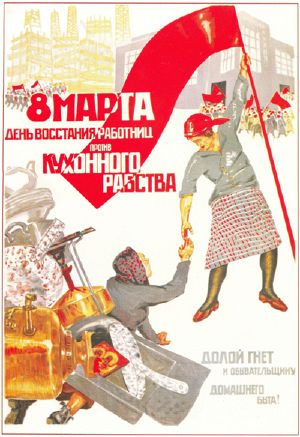
While the Russian economy was being transformed, the social life of the people underwent equally drastic changes. From the beginning of the revolution, the government attempted to weaken patriarchal domination of the family. Divorce no longer required court procedure; and to make women completely free of the responsibilities of childbearing, abortion was legalized as early as 1920. As a side-effect, the emancipation of the women increased the labor market. Girls were encouraged to secure an education and pursue a career in the factory or the office. Communal nurseries were set up for the care of small children and efforts were made to shift the center of people's social life from the home to educational and recreational groups, the soviet clubs.
The regime abandoned the tsarist policy of discriminating against national minorities in favor of a policy of incorporating the more than two hundred minority groups into Soviet life. Another feature of the regime was the extension of medical services. Campaigns were carried out against typhus, cholera, and malaria; the number of doctors was increased as rapidly as facilities and training would permit; and infant mortality rates rapidly decreased while life expectancy rapidly increased.
The government also promoted atheism and materialism, which formed the basis of Marxist theory. It opposed organized religion, especially in order to break the power of the Russian Orthodox Church, a former pillar of the old tsarist regime and a major barrier to social change. Many religious leaders were sent to internal exile camps. Members of the party were forbidden to attend religious services and the education system was separated from the Church. Religious teaching was prohibited except in the home and atheist instruction was stressed in the schools.
Industrialization and collectivization
The years from 1929 to 1939 comprised a tumultuous decade in Russian history‚ÄĒa period of massive industrialization and internal struggles as Joseph Stalin (1878 ‚Äď 1953) established near total control over Russian society, wielding virtually unrestrained power. Following Lenin's death in January 1924, Stalin wrestled to gain control of the Soviet Union with rival factions in the Politburo, especially Leon Trotsky's. By 1928, with the Trotskyists either exiled or rendered powerless, Stalin was ready to put a radical program of industrialization into action.
In 1928 Stalin proposed the First Five-Year Plan. Abolishing the NEP, it was the first of a number of plans aimed at swift accumulation of capital resources through the build-up of heavy industry, the collectivization of agriculture, and the restricted manufacture of consumer goods. For the first time in history a government controlled all economic activity.
As a part of the plan, the government took control of agriculture through the state and collective farms. By a decree of February 1930, about one million individual peasants were forced off their land. Many peasants strongly opposed regimentation by the state, often slaughtering their herds when faced with the loss of their land. In some sections they revolted, and countless peasants were executed.
The combination of bad weather, deficiencies of the hastily-established collective farms, and massive confiscation of grain precipitated a serious famine, and several million peasants died of starvation, mostly in Ukraine and parts of southwestern Russia. Deteriorating conditions in the countryside drove millions of desperate peasants to the rapidly growing cities, fueling industrialization, and vastly increasing Russia's urban population in the space of just a few years.
The plans received remarkable results in areas aside from agriculture. Russia, in many measures the poorest nation in Europe at the time of the Bolshevik Revolution, now industrialized at a phenomenal rate, far surpassing Germany's pace of industrialization in the nineteenth century and Japan's earlier in the twentieth century.
While the Five-Year Plans were forging ahead, Stalin was establishing his personal power. The NKVD gathered tens of thousands of Soviet citizens to face arrest, deportation, or execution. Of the six original members of the 1920 Politburo who survived Lenin, all were purged by Stalin. Old Bolsheviks who had been loyal comrades of Lenin, high officers in the Red Army, and directors of industry were liquidated in the Great Purges. Purges in other Soviet republics also helped centralize control in the USSR.
Stalin's repressions led to the creation of a vast system of internal exile, of considerably greater dimensions than those set up in the past by the tsars. Draconian penalties were introduced and many citizens were prosecuted for fictitious crimes of sabotage and espionage. The labor provided by convicts working in the labor camps of the Gulag system became an important component of the industrialization effort, especially in Siberia. Perhaps around five percent of the population passed through the Gulag system.
Rise of Hitler
The Soviet Union viewed the 1933 accession of fervently anti-Communist Hitler's government to power in Germany with the great alarm from the onset, especially since Hitler proclaimed the Drang nach Osten as one of the major objectives in his vision of the German strategy of Lebensraum. The Soviets supported the republicans of Spain who struggled against the fascist German and Italian troops in the Spanish Civil War. In 1938-1939, immediately prior to World War II, the Soviet Union successfully fought against Imperial Japan in the Soviet-Japanese Border Wars in the Russian Far East, which led to the Soviet-Japanese neutrality and the tense border peace that lasted until August 1945.
In 1938 Germany annexed Austria and, together with major Western European powers, signed the Munich Agreement following which Germany, Hungary and Poland divided the Czech territory. German plans for further eastward expansion as well as the lack of resolve from the Western powers to oppose it became more apparent. Despite the fact that the Soviet Union strongly opposed the Munich deal and repeatedly reaffirmed its readiness to militarily back the Soviet commitments given earlier to Czechoslovakia, the Western Betrayal of Czechoslovakia further increased fears in the Soviet Union of a coming German attack, which led the Soviet Union to rush the modernization of Soviet military industry and carry its own diplomatic maneuvers. In 1939 the Soviet Union signed the Molotov-Ribbentrop non-aggression pact with with Nazi Germany, dividing spheres of influence between themselves in Eastern Europe. Following the agreement, the USSR normalized relations with Nazi Germany and resumed the Soviet-German trade.
World War II
On September 17, 1939, 17 days after the start of World War II and victorious German advance deep into the Polish territory, the Soviet Red Army invaded eastern portions of Poland. As a result, the Belarusian and Ukrainian Soviet republics' western borders were moved west and the new Soviet western border was drawn close to the original Curzon line.
In the meantime, the negotiations with Finland about the Soviet-proposed land swap that would redraw the Soviet-Finnish border further away from Leningrad failed; and in December, 1939 the USSR started a campaign against Finland, known as the Winter War (1939‚Äď1940). The war took a heavy toll on the Red Army but forced Finland to sign a Moscow Peace Treaty and cede the Karelian Isthmus and Ladoga Karelia.
In the summer of 1940, the USSR issued an ultimatum to Romania forcing it to cede the territories of Bessarabia and Northern Bukovina. At the same time, the Soviet Union also occupied the three formerly independent Baltic states of Estonia, Latvia and Lithuania.
The peace with Germany was tense, as both sides were preparing for the military conflict, and abruptly ended when the Axis forces led by Germany swept across the Soviet border on June 22, 1941. By the autumn of 1941, the German army had seized Ukraine, besieged Leningrad, and threatened to capture the capital, Moscow, itself. Despite the fact that in December 1941, the Red Army threw off the German forces from Moscow in a desperate but successful counterattack, the Germans retained the strategic initiative for approximately another year and held a deep offensive in the south-eastern direction, reaching the Volga and the Caucasus. However, two major German defeats in Stalingrad and Kursk proved decisive and reversed the course of World War II.
By the end of 1943, the Red Army had broken through the German siege of Leningrad and liberated much of Ukraine, much of Western Russia and moved into Belarus. By the end of 1944, the front had moved beyond the 1939 Soviet frontiers into eastern Europe. Soviet forces drove into eastern Germany, capturing Berlin in May 1945. The war with Germany thus ended triumphantly for the Soviet Union. As agreed at the Yalta Conference, three months after the Victory Day in Europe the USSR launched the Operation August Storm defeating the Japanese troops in neighboring Manchuria, the last Soviet battle of World War II.
Although the Soviet Union was victorious in World War II, the war resulted in around 26‚Äď27 million Soviet deaths (estimates vary), and had devastated the Soviet economy. Some 1710 towns and 70 thousand settlements were destroyed. The occupied territories suffered from the ravages of German occupation and deportations of slave labor in Germany. Thirteen million Soviet citizens died due to famine, absence of elementary medical aid, and slave labor. The Nazi Genocide of the Jews carried by German Einsatzgruppen, along with local collaborators resulted in the almost complete annihilation of the Jewish population over the entire territory occupied by Germany and its allies. During the occupation, Russia's Leningrad, now Saint Petersburg, region lost around a quarter of its population. Soviet Belarus lost from a quarter to a third of its population. Between 2.8 - 3.3 million Soviet prisoners of war (of 5.5 million) died in German camps.
Cold War
Collaboration among the major Allied nations had won the war and was supposed to serve as the basis for post-war reconstruction and security. However, the conflict between Soviet and U.S. national interests, known as the Cold War, came to dominate the international stage in the post-war period.
The Cold War emerged out of a conflict between Stalin and U.S. President Harry Truman over the future of Eastern Europe during the Potsdam Conference in the summer of 1945. Russia had suffered three devastating Western onslaughts in the previous 150 years during the Napoleonic Wars, the First World War, and the Second World War, and Stalin's goal was to establish a buffer zone of states between Germany and the Soviet Union.
Truman charged that Stalin had betrayed the Yalta agreement. With Eastern Europe under Red Army occupation, Stalin was also biding his time, as his own atomic bomb project was steadily and secretly progressing.
In April 1949 the United States sponsored the North Atlantic Treaty Organization (NATO), a mutual defense pact in which most Western nations pledged to treat an armed attack against one nation as an assault on all. The Soviet Union established an Eastern counterpart to NATO in 1955, dubbed the Warsaw Pact. The division of Europe into Western and Soviet blocks later took on a more global character, especially after 1949, when the U.S. nuclear monopoly ended with the testing of a Soviet bomb and the communist takeover in China.
The foremost objectives of Soviet foreign policy were the maintenance and enhancement of national security and the maintenance of hegemony over Eastern Europe. The Soviet Union maintained its dominance over the Warsaw Pact through crushing the 1956 Hungarian Revolution, suppressing the Prague Spring in Czechoslovakia in 1968, and supporting the suppression of the Solidarity movement in Poland in the early 1980s. The Soviet Union opposed the United States in a number of proxy conflicts all over the world, including the Korean and Vietnamese Wars.
As the Soviet Union continued to maintain tight control over its sphere of influence in Eastern Europe, the Cold War gave way to Détente and a more complicated pattern of international relations in the 1970s in which the world was no longer clearly split into two clearly opposed blocs. Less powerful countries had more room to assert their independence, and the two superpowers were partially able to recognize their common interest in trying to check the further spread and proliferation of nuclear weapons in treaties such as SALT I, SALT II, and the Anti-Ballistic Missile Treaty.
U.S.-Soviet relations deteriorated following the beginning of the nine-year Soviet War in Afghanistan in 1979 and the 1980 election of Ronald Reagan, a staunch anti-communist, but improved as the Soviet bloc began to unravel in the late 1980s. With the collapse of the Soviet Union in 1991, Russia lost the superpower status that it had won in the Second World War.
The Khrushchev and Brezhnev years
In the power struggle that erupted after Stalin's death in 1953, his closest followers lost out. Nikita Khrushchev (1894-1971) solidified his position in a speech before the Twentieth Congress of the Communist Party in 1956 detailing Stalin's atrocities. In 1964, Khrushchev was ousted by the Communist Party's Central Committee, charging him with a host of errors that included Soviet setbacks such as the Cuban Missile Crisis. After a brief period of collective leadership, a veteran bureaucrat, Leonid Brezhnev (1906-1982), took Khrushchev's place. Brezhnev followed Stalin's emphasis on heavy industry, and also attempted to ease relationships with the United States. However, his latter mentioned emphasis led to post-mortem criticism due to the falling standard of living that resulted.
On October 4, 1957 the Soviet Union launched the first space satellite Sputnik. On April 12, 1961, Yuri Gagarin became the first human to travel into space in the Soviet spaceship Vostok 1. In the 1960s the USSR became a leading producer and exporter of petroleum and natural gas.
Gorbachev, perestroika and glasnost
Two developments dominated the decade that followed: the increasingly apparent crumbling of the Soviet Union's economic and political structures, and the patchwork attempts at reforms to reverse that process. After the rapid succession of former KGB Chief Yuri Andropov (1914-1984) and Konstantin Chernenko (1911-1985), transitional figures with deep roots in Brezhnevite tradition, to the position of General Secretary of the Communist Party, Mikhail Gorbachev (elected as general secretary in 1985 at the age of 54)) announced perestroika (economic restructuring) in an attempt to modernize Soviet communism, and made significant changes in the party leadership.
In June 1988, Gorbachev launched radical reforms to reduce party control of the government apparatus, and proposed a new executive in the form of a presidential system, as well as a new legislative element, to be called the Congress of People's Deputies. On March 15, 1990, Gorbachev was elected as the first executive President of the Soviet Union. However, Gorbachev's social reforms led to unintended consequences. Because of his policy of glasnost (openness), which facilitated public access to information after decades of government repression, social problems received wider public attention, undermining the Communist Party's authority.
In the revolutions of 1989, the USSR lost its satellites in Eastern Europe. Glasnost allowed ethnic and nationalist disaffection to reach the surface. Many constituent republics, especially the Baltic republics, Georgian SSR and Moldavian SSR, sought greater autonomy, which Moscow was unwilling to provide. Gorbachev's attempts at economic reform were not sufficient, and the Soviet government left intact most of the fundamental elements of communist economy. Suffering from low pricing of petroleum and natural gas, ongoing war in Afghanistan, outdated industry and pervasive corruption, the Soviet planned economy proved to be ineffective, and by 1990 the Soviet government had lost control over economic conditions. Due to price control, there were shortages of almost all products, reaching their peak in the end of 1991, when people had to stand in long lines to be lucky enough to buy even the essentials. Control over the constituent republics was also relaxed, and they began to assert their national sovereignty over Moscow.
Yeltsin elected president
The tension between Soviet Union and Russian SFSR authorities came to be personified in the bitter power struggle between Gorbachev and Boris Yeltsin. Squeezed out of Union politics by Gorbachev in 1987, Yeltsin, an old-style party boss with no dissident background or contacts, needed an alternative platform to challenge Gorbachev. He established it by representing himself as a committed democrat. In a remarkable reversal of fortunes, he gained election as chairman of the Russian republic's new Supreme Soviet in May 1990. The following month, he secured legislation giving Russian laws priority over Soviet laws and withholding two-thirds of the budget. In the first Russian presidential election in 1991 Yeltsin became president of the Russian SFSR.
Coup attempted
At last Gorbachev attempted to restructure the Soviet Union into a less centralized state. However, on August 19, 1991, a coup against Gorbachev, conspired by senior Soviet officials, was attempted. The coup faced wide popular opposition and collapsed in three days, but disintegration of the Union became imminent. The Russian government took over most of the Soviet Union government institutions on its territory. Because of the dominant position of Russians in the Soviet Union, most gave little thought to any distinction between Russia and the Soviet Union before the late 1980s. In the Soviet Union, only the Russian SFSR lacked even the paltry instruments of statehood that the other republics possessed, such as its own republic-level Communist Party branch, trade union councils, Academy of Sciences, and the like. The Communist Party of the Soviet Union was banned in Russia in 1991-1992, although no rehabilitation has ever taken place, and many of its members became top Russian officials.
Soviet Union collapses
However, as the Soviet government was still opposed to market reforms, the economic situation continued to deteriorate. By December 1991, the shortages had resulted in the introduction of food rationing in Moscow and Saint Petersburg for the first time since World War II. Russia received humanitarian food aid from abroad.
On December 1, 1991, the Ukrainian people voted for independence. The Presidents of Russia, Ukraine and Belarus met in Belovezh Forest, near Brest, Belarus, on December 8, founded the Commonwealth of Independent States and declared the end of the Soviet Union in the Belavezha Accords. Gorbachev reluctantly agreed with Yeltsin, on December 17, to dissolve the Soviet Union. Gorbachev resigned on Christmas Day, and the Russian Federation (formerly the Russian Soviet Federative Socialist Republic took power on December 26. The Russian government lifted price control on January 2, 1992. Prices rose dramatically, but shortages disappeared.
Economic crisis
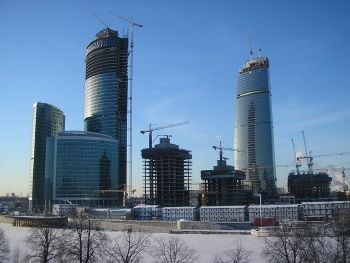
After the disintegration of the USSR, the Russian economy went through a crisis. The "shock therapy" recommendations by the US and the IMF, of ending Soviet-era price controls, drastic cuts in state spending, and an open foreign trade regime in early 1992, resulted in the economy being shattered, with millions plunging into poverty and a severe fall in the standard of living, and triggered an explosion in corruption and organized crime. Russia took responsibility for settling the USSR's external debts, even though its population made up just half of the population of the USSR at the time of its dissolution.
The largest state enterprises (petroleum, metallurgy, and the like) were controversially privatized by President Boris Yeltsin to insiders (who became billionaires virtually overnight) for far less than they were worth, while the majority of the population plunged into poverty. Corruption became rampant, and the Yeltsin government was accused of conspiring with insiders to loot countless billions in cash and assets from the State (for example, Yeltsin's son-in-law became the CEO of Aeroflot, Russia's largest airline).
Meanwhile, the profusion of small parties and their aversion to coherent alliances left the legislature chaotic. During 1993, Yeltsin's rift with the parliamentary leadership led to a constitutional crisis. The crisis climaxed on October 3, when Yeltsin chose a radical solution to settle his dispute with parliament: he called up tanks to shell the Russian White House, blasting out his opponents. As Yeltsin was taking the unconstitutional step of dissolving the legislature, Russia came close to a serious civil conflict. Yeltsin was then free to impose the Russian constitution with strong presidential powers, which was approved by referendum in December 1993. The cohesion of the Russian Federation was also threatened when the republic of Chechnya attempted to break away, leading to two bloody conflicts.
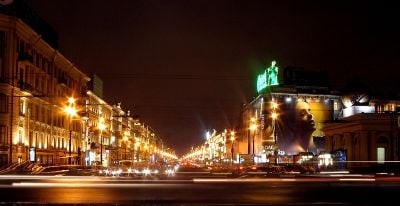
By the mid-1990s Russia had a system of multiparty electoral politics. But it was harder to establish a representative government because of two structural problems‚ÄĒthe struggle between president and parliament and the anarchic party system.
Meanwhile, the central government had lost control of the localities, bureaucracy, and economic fiefdoms; tax revenues had collapsed. Still in deep depression by the mid-1990s, Russia's economy was hit further by a financial crash in 1998, after which Yeltsin was at the end of his political career. Just hours before the first day of 2000, Yeltsin made a surprise announcement of his resignation, leaving the government in the hands of the little-known Prime Minister Vladimir Putin, a former KGB official and head of the KGB's post-Soviet successor agency FSB.
Putin named president
In 2000, the new acting president defeated his opponents in the presidential election on March 26, and won a landslide four years later. International observers were alarmed by late 2004 moves to further tighten the presidency's control over parliament, civil society, and regional officeholders. Nevertheless, reversion to a socialist command economy seemed almost impossible, meeting widespread relief in the West. Russia's economy also recovered somewhat since 1999, thanks to the rapid rise of the world price of oil and gas, one of Russia's largest exports.
Conflicts
The 1990s were plagued by armed ethnic conflicts in the North Caucasus. Such conflicts took a form of separatist Islamist insurrections against federal power (most notably in Chechnya), or of ethnic/clan conflicts between local groups (e.g., in North Ossetia-Alania between Ossetians and Ingushs, or between different clans in Chechnya). Since the Chechen separatists declared independence in the early 1990s, an intermittent guerrilla war (First Chechen War, Second Chechen War) has been fought between disparate Chechen groups and the Russian military. Russia has severely disabled the Chechen rebel movement, although sporadic violence still occurs throughout the North Caucasus.
Following a diplomatic crisis with neighboring Georgia; the Russo-Georgian War took place during 1‚Äď12 August 2008, resulting in Russia imposing two unrecognized states in the territory of Georgia.
In 2014, following a revolution in Ukraine, Russia invaded the neighboring country’s Crimean peninsula, contributing to the outbreak of war in eastern Ukraine. The ongoing Russo-Ukrainian War steeply escalated on February 24, 2022, when Russia launched a full-scale invasion of Ukraine. It marks the largest conventional war in Europe since World War II, and was met with widespread international condemnation and expanded sanctions against Russia. As a result, Russia was expelled from the Council of Europe, as well as being suspended from the United Nations Human Rights Council.
Government and politics
The politics of the Russian Federation take place in a framework of a federal presidential republic. According to the 1993 constitution, the president is head of state, and of a pluriform multi-party system with executive power exercised by the government, headed by the prime minister, who is appointed by the president by the parliament's approbation. Legislative power is vested in the two chambers of the federal assembly, while the president and the government issue numerous legally binding by-laws. Although Russia has traditionally been ruled by absolute monarchs and dictators today it has a democratic system of government.
Structure
For the executive, the president is elected by popular vote for a six-year term (eligible for a second term, but not for a third consecutive term). The president appoints a cabinet comprising the premier and his deputies, ministers, and selected other individuals.
The legislature, termed the Federal Assembly or Federalnoye Sobraniye, consists of two chambers, the 450-member State Duma or Gosudarstvennaya Duma and the 178-member Federation Council or Soviet Federatsii.
Duma members, who serve four-year terms, are put forward from party lists on a basis of proportional representation. A party gains representation by winning at least five percent of the vote. There are 225 party list seats, and 225 seats representing electorates. Sobraniye members are appointed by the top executive and legislative officials in each of the 88 federal administrative units - oblasts, krays, republics, autonomous okrugs and oblasts, and the federal cities of Moscow and Saint Petersburg, to serve four-year terms. United Russia won 37.1 percent of the vote in 2003, CPRF 12.7 percent, LDPR 11.6 percent, Motherland 9.1 percent, and other 29.5 percent.
The Russian judiciary is divided into three branches: The courts of general jurisdiction (including military courts) subordinated to the Supreme Court; the arbitration (commercial) court system under the High Court of Arbitration; and the Constitutional Court (including constitutional courts in a number of administrative entities). Civil and criminal cases are tried in municipal courts, which hear more than 90 percent of all civil and criminal cases, courts of appeals, and higher courts. Judges for all courts are appointed for life by the Federation Council on the recommendation of the president.
The legal system is based on civil law system, there is judicial review of legislative acts, and the Russian Federation has not accepted compulsory International Court of Justice jurisdiction. Constitutional justice is based on the equality of all citizens. Judges are independent and subject to the law. Trials are to be open, and the accused is guaranteed a defense.
Constitutional challenges
Since gaining its independence with the collapse of the Soviet Union at the end of 1991, Russia has faced serious challenges in its efforts to forge a political system to follow nearly 75 years of Soviet rule. For instance, leading figures in the legislative and executive branches have put forth opposing views of Russia's political direction and the governmental instruments that should be used to follow it. That conflict reached a climax in September and October 1993, when President Boris Yeltsin used military force to dissolve the parliament and called for new legislative elections. This event marked the end of Russia's first constitutional period, which was defined by the much-amended constitution adopted by the Russian Republic in 1978. A new constitution, creating a strong presidency, was approved by referendum in December 1993.
With a new constitution and a new parliament representing diverse parties and factions, Russia's political structure subsequently showed signs of stabilization. As the transition period extended into the mid-1990s, the power of the national government continued to wane as Russia's regions gained political and economic concessions from Moscow. Although the struggle between executive and legislative branches was partially resolved by the new constitution, the two branches continued to represent fundamentally opposing visions of Russia's future. Most of the time, the executive was the center of reform, and the lower house of the parliament, the State Duma, was a bastion of anti-reform communists and nationalists.
Foreign relations
The Russian Federation (Russia), recognized in international law as continuing the legal personality of the former Soviet Union, continues to implement the international commitments of the USSR, and has assumed the USSR's permanent seat on the UN Security Council, membership in other international organizations, the rights and obligations under international treaties and property and debts. Russia is one of the key players in international relations. As one of five permanent members of the UN Security Council, Russia has a special responsibility for maintaining international peace and security.
Russia is the leading nation of the Commonwealth of Independent States.
Since 1994, Russia has participated as a member of the Group of Eight (G8) industrialized nations, although the Finance Ministers/Secretaries of Finance and Leaders of the G7 central banks continue to meet several times a year, without their Russian counterparts. Russia is a member of the Council of Europe and OSCE. Russia takes a special role in the organizations created on the territory of the former USSR, largely under the leadership of Russia: CIS, EurAsEC, CSTO, SCO.
The collapse of the Soviet Union has also resulted in Russia becoming a somewhat more NATO-friendly country and the establishment of the NATO-Russia Council, which brings together the NATO members and the Russian Federation; however, Russia has not formally joined the NATO as an ally, nor has Russia expressed any desire to join NATO.
Russia has a multifaceted foreign policy. It maintains diplomatic relations with 178 countries and has 140 embassies. Russia's foreign policy is determined by the President and implemented by the Ministry of Foreign Affairs.
Subdivisions
The Russian Federation comprises 85  federal subjects, namely:
- 47 oblasts (provinces)
- 21 republics (states) which enjoy a high degree of autonomy on most issues and which correspond to some of Russia's numerous ethnic minorities
- eight krais (territories)
- six okrugs (autonomous districts)
- two federal cities (Moscow and St. Petersburg)
- the Jewish Autonomous Oblast.
Federal subjects are grouped into seven federal districts, each administered by an envoy appointed by the President of Russia. Unlike the federal subjects, the federal districts are not a sub-national level of government, but are a level of administration of the federal government. Federal districts' envoys serve as liaisons between the federal subjects and the federal government and are primarily responsible for overseeing the compliance of the federal subjects with the federal laws.
For economic and statistical purposes the federal subjects are grouped into 12 economic regions. Economic regions and their parts sharing common economic trends are in turn grouped into economic zones and macrozones.
Military
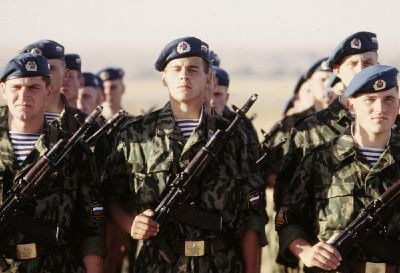
After the dissolution of the USSR, in 1991, Russia assumed control of Soviet assets abroad, and received the lion's share of the Soviet Union's production facilities and military forces. About 70 percent of the former Soviet Union's defense industries are located in the Russian Federation.
The Russian military is divided into the ground forces, navy, and air force. There are also three independent arms of service: Strategic Rocket Forces, Russian Space Forces (VKS), and the airborne troops. Russia ranks at or near the top of many measures of military power including in numbers of tanks, fighter aircraft and naval vessels; it has the largest stockpile of nuclear weapons. It also has the second largest fleet of ballistic missile submarines, and is the only country apart from the U.S. with a modern strategic bomber force. As of 2005, 330,000 men are brought into the army via conscription annually, though the army in 2007 was phasing out conscription altogether.
Defense spending is consistently increasing by at least a minimum of one-third year-on-year, leading to overall defense expenditure almost quadrupling over the past six years. Official government military spending for 2007 was $32.4-billion, though various sources, including the US Department of Defense, have estimated Russia’s military expenditures to be considerably higher than the reported amount. By some estimates, overall Russian defense expenditure is now at the second highest in the world after the US. The recent steps towards modernization of the armed forces has been made possible by Russia's spectacular economic resurgence based on oil and gas revenues as well a strengthening of its own domestic market. Currently, the military is in the middle of a major equipment upgrade, with the government in the process of spending about $200-billion (what equals to about $400-billion in PPP dollars) on development and production of military equipment between 2006-2015. Russia is the world's top supplier of weapons, a spot it has held since 2001, accounting for around 30 percent of worldwide weapons sales. Russia is the principal weapons supplier of China and India, and provides weapons to Iran, Algeria, Venezuela and other countries.
Economy
Russia's economy has improved since the 1998 financial crisis. Poverty has declined steadily and the middle class has continued to expand.
Oil export earnings allowed Russia to increase its foreign reserves. During Putin's first administration, a number of important reforms were implemented in the areas of tax, banking, labor, and land codes. These achievements raised business and investor confidence in Russia's economic prospects. Growth was driven by non-tradable services and goods for the domestic market, as opposed to oil or mineral extraction and exports. In December 2011, Russia was approved as a member of the World Trade Organization after 18 years of dialogue, World Trade Organization.
Despite Russia's recent success, serious problems persist. Oil, natural gas, metals, and timber account for more than 80 percent of exports and 32 percent of government revenues, leaving the country vulnerable to swings in world commodity prices. Russia's manufacturing base is dilapidated and must be replaced or modernized if the country is to achieve broad-based economic growth. The banking system, while increasing consumer lending and growing at a high rate, is still small relative to the banking sectors of Russia's emerging market peers.
The economic development of the country has been extremely uneven geographically. The Moscow region contributes one-third of the country's GDP while having only a tenth of its population. While the huge capital region of Moscow is an affluent metropolis, much of the country, especially indigenous and rural communities in Asia, lags significantly behind.
Political uncertainties ahead of the elections, corruption, and widespread lack of trust in institutions continue to dampen domestic and foreign investor sentiment. Russia has made little progress in building the rule of law, the bedrock of a modern market economy. The government has promised additional legislation to make its intellectual property protection WTO-consistent, but enforcement remains problematic.
Export commodities include petroleum and petroleum products, natural gas, wood and wood products, metals, chemicals, and a wide variety of civilian and military manufactures. Import commodities include machinery and equipment, consumer goods, medicines, meat, sugar, semi-finished metal products.
Demographics
Population
Though Russia's population is large, close to 150,000,000, its average population density is low because of its enormous size. Its population is densest in European Russia, near the Ural Mountains, and in the southwest Siberia. About 75 percent of the population live in urban areas. The two largest cities in Russia are Moscow and Saint Petersburg. Eleven other cities have between one and two million inhabitants: Chelyabinsk, Kazan, Novosibirsk, Nizhny Novgorod, Omsk, Perm, Rostov-on-Don, Samara, Ufa, Volgograd, and Yekaterinburg.
Health
Russia's constitution guarantees free, universal health care for all Russian citizens. While Russia has more physicians, hospitals, and health care workers than almost any other country in the world, it has struggled to provide high levels of health care services. In the early twenty-first century, the health of the Russian population declined considerably, a result of social, economic, and lifestyle changes. Life expectancy also declined. The biggest factor contributing to this relatively low life expectancy is a high mortality rate among working-age males due to preventable causes such as alcohol, smoking, traffic accidents, and violent crimes.
Ethnicity
The Russian Federation is home to as many as 160 different ethnic groups and indigenous peoples, although the majority (approximately 80 percent) are ethnic Russians. Other ethnicities include Tatars, Ukrainians, Bashkirs, Armenians, and Chuvashes. Nearly all groups besides Russians live compactly in their respective regions. Ethnic relations are stressed with tension resulting from centuries of Russian and Soviet domination and were activated by the collapse of the Soviet state. Conflicts center on political control, rights to natural resources, relocation of ethnic groups, and the revitalization of ethnic cultures, religions, languages, and identities. The Soviet regime compelled the use of the Russian language, forcibly relocated whole populations, installed ethnic Russian political elites in non-Russian regions, and drained regional resources.
Religion
Christianity, Islam, Buddhism, and Judaism are Russia’s traditional religions. Estimates of the number of believers range from 85-90 percent (non-atheists) to 7-15 percent (people who attend worship at least once a month). Estimates of believers widely fluctuate between sources, and some reports put the number of non-believers in Russia as high as 24-48 percent of the population. The ancestors of today’s Russians adopted Orthodox Christianity in the tenth century. The majority of Russian citizens, and as many as 80 percent of ethnic Russians, self-identify as Russian Orthodox. According to the Russian Public Opinion Research Center, 63 percent of respondents consider themselves Russian Orthodox. This makes the Russian Orthodox Church by far the most widespread religion. However, the vast majority of Orthodox believers do not attend church on a regular basis. The percentage of Russians who attend church services on a weekly basis was estimated by the Interior Ministry to be less than 2 percent. Nonetheless, the church is widely respected by both believers and non-believers, who see it as a symbol of Russian heritage and culture. Small numbers of other Christian denominations exist. The number of Roman Catholics is estimated to be approximately 400,000 to 500,000; Armenian Gregorian, about 1.2 million; and Protestants, about 1 million.
Russia has from 10 to 20 million Muslims, constituting the largest religious minority. Most Muslims live in the Volga-Ural region, as well as in the North Caucasus, Moscow, Saint Petersburg and western Siberia. In Russia there are more than 6000 mosques (in 1991 it was about 100). A particularly large number of Muslims live in rural areas, mainly in the Caucasus. According to the Federation of Jewish Communities of Russia, the number of Jews in Russia is about 1.5 million. Of these, according to the Federation of Jewish Communities of Russia, Moscow is home to some 500,000 Jews, and Saint Petersburg about 170,000. In Russia there are about 70 synagogues.
Buddhism is traditional for three regions of the Russian Federation: Buryatia, Tuva and Kalmykia, and those practicing Buddhism number 1.5 to 2 million. Some residents of the Siberian and Far Eastern regions, including Yakutia and Chukotka, practice pantheistic and pagan rites, along with the major religions.
Induction into religion takes place primarily along ethnic lines. Ethnic Russians are mainly Orthodox whereas most people of Turkic extraction are Sunni Muslim. On the other hand, the New Age movement has led to emergence of some "non-traditional" religions in large cities. On May 17, 2007, an Act of Canonical Communion was signed between the Moscow Patriarchate of the Russian Orthodox Church and the Russian Orthodox Church Outside Russia.
Language
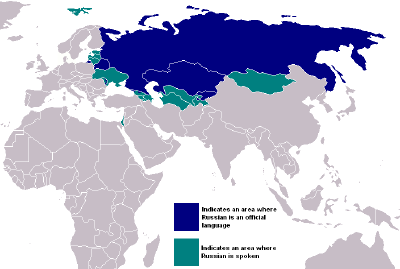
Russian is the only official state language, but the individual republics have often made their native language co-official next to Russian. The Cyrillic alphabet is the only official script, which means that these languages must be written in Cyrillic in official texts. Russian is the most geographically widespread language of Eurasia and the most widely spoken of the Slavic languages.
Russian belongs to the family of Indo-European languages and is one of three living members of the East Slavic languages; the others being Belarusian and Ukrainian (and possibly Rusyn, often considered a dialect of Ukrainian). The roots of the Russian language are some 3000 to 4000 years old. Written examples of Old East Slavonic are attested from the tenth century onwards.
While Russian preserves much of East Slavonic grammar and a Common Slavonic word base, modern Russian exhibits a large stock of borrowed international vocabulary for politics, science, and technology. Due to the status of the Soviet Union as a superpower, Russian had great political importance in the twentieth century. Hence, the language is still one of the official languages of the United Nations.
Men and women
Traditionally, newly married women were subservient in the families of their husbands until they had borne sons. Under communist ideology, which aimed to free women from oppressive norms, women were trained to take up men’s work, such as operating agricultural machinery, working in construction, and working on roads and railways. Nurseries and day care centers were set up to free women from child rearing. Soviet women gained authority and status in medicine and education, and increased political representation. But as unemployment grew in the 1990s, women were the first to lose their jobs. As a traditionalist view of work and family reappeared, some women whose husbands had succeeded in the new economy were glad to become full-time mothers. Fewer women hold political office, and significant numbers of young women have been lured into prostitution, which is illegal, but punished by small fines.
Marriage and the family
Romantic love is considered the starting point of marriage, although more pragmatic motivations include improving economic status or housing prospects. People meet at school, university, at work, or at discos and clubs. Premarital sex is accepted, and cohabitation is tolerated, although the vast majority of adults marry by age 40. A large proportion of all marriages ends in divorce, resulting from economic hardship, or alcohol abuse. Ethnic intermarriage became common in the Soviet era.
Traditionally, the multi-generational extended family characterized peasant life until the twentieth century, and strict patriarchal control over the household was common to all social classes. The communist revolution sought to replace the traditional family with non-authoritarian communal living units, in a short-lived experiment that failed by the end of the 1930s.
The nuclear family has become the preferred domestic unit. While most married couples want their own apartment, housing shortages and expense mean families often live in apartments holding three generations, with a widowed parent providing childcare, food preparation, and money.
During and since the Soviet period, the most important real property consisted of apartments and dachas (summer homes). Children must be officially registered as residents of those places before the death of the title holder, or the title can revert to the government, although inheritance laws were being reformulated.
Women give birth in crowded maternity hospitals, and stay in the hospital a week after a birth. Government maternity benefits and laws on maternity leave are generous. Infants are wrapped tightly. Babies are kept very warm.
Education
Russia's free, widespread and in-depth educational system, inherited with almost no changes from the Soviet Union, produces 100 percent literacy. Pre-school education is well developed, with four-fifths of children aged three to six attending day nurseries or kindergartens. School is compulsory for nine years, from age seven, leading to a basic general education certificate. Two or three years are required for the secondary-level certificate. Non-Russian pupils are taught in their own language, although Russian is compulsory at the secondary schools
Ninety seven percent of children receive their compulsory nine-year basic or complete 11-year education in Russian. Entry to higher education is selective and highly competitive. Most undergraduate courses require five years. As a result of great emphasis on science and technology in education, Russian medical, mathematical, scientific, and space and aviation research is generally of a high order.
The Russian educational system may be arranged into three major groups: basic education, higher education and postgraduate education. Basic education in Russia takes either 10 (skipping the fourth form) or 11 years to complete, depending on the school. In Russia school accreditation/national recognition is directly overseen by the Education Ministry of Russia. Since 1981, Russia has followed the UNESCO international regulations to ensure Russian institutions and international institutions meet high quality standards. It is illegal for a school to operate without government approval.
Under the Soviet regime, the state owned and operated nearly every school, the curriculum was rigid, and the system aimed to indoctrinate students in the communist system. Education at all levels was free for anybody who could pass entrance exams. In addition, students were provided with small scholarships and free housing. This was considered crucial because it provided access to higher education to all skilled students, as opposed to only those who could afford it. Free higher education is the main reason why more than 20 percent of Russians age 30‚Äď59 hold six-year degrees (this number is twice as high as that of the United States). The downside of that system was that institutions had to be funded entirely from the federal and regional budgets; therefore, after the collapse of the Soviet Union, expenses on education took a big blow; institutions found themselves unable to provide adequate teachers' salaries, students' scholarships, and to maintain their facilities. To address the issue, many state institutions started to open commercial positions. The number of those positions has been growing steadily since then. Many private higher education institutions have emerged, mostly in the fields where the Soviet system was inadequate or was unable to provide enough specialists for post-Soviet realities, such as economics, business/management, and law.
Class
For hundreds of years, Russian society consisted of caste-like aristocratic and merchant classes, and a largely impoverished rural peasant and serf population. Emancipation in 1861, brought development along capitalist lines‚ÄĒpeasants migrated to urban factories to form a poor working class. Under communist ideology, Stalin in the 1930s, killed, imprisoned, exiled, or forced aristocrats, merchants, and well-off peasants kulaks to emigrate, and confiscated their property. Soviet society became a class-conscious state where communist elites had special access to goods, services, and housing. Those who controlled goods and services would channel them to benefit themselves through a set of practices known as blat.
Post communist privatization allowed many of the communist elites to build large fortunes by using their political status to gain direct ownership of state resources and industries. But industrial collapse, inflation, financial crises, and privatization structures meant most of the population remained impoverished. Late-model Mercedes or Jeeps, new red brick dachas, designer clothes, cell phones, and heavy gold chains, rings, and diamonds are linked with the ‚Äúnew rich.‚ÄĚ
Culture
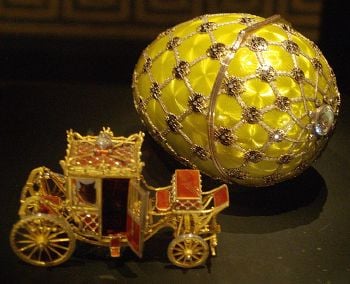
The culture of Russia is a hybrid that developed from native Slavic culture with borrowings from foreign cultures. In the Kievan period (c. tenth‚Äďthirteenth centuries), Russia borrowed from Eastern Orthodox Byzantine culture. During the Muscovite period (c. fourteenth‚Äďseventeenth centuries), Mongol hordes brought Asiatic influences. In the modern period (since the eighteenth century), Russia drew upon the cultural heritage of western Europe.
Russian language and culture has dominated, since Russians constitute the vast majority of the population, and because many times through history the cultures of other nationalities were suppressed through russification.
The politics of the Soviet Union with respect to culture was controversial: on one side there was a politically-motivated desire to create a "Soviet people," which was expressed in the notion of Soviet culture, exemplified by Socialist Realism. From the other side there were periodical campaigns of preservation of national cultures: every ethnicity had "great national writers" and folk cultural practices were officially supported.
Architecture
At the time of the 1917 revolution, the population was more than 80 percent rural, living in rural villages. The Soviet period brought movement to the cities, so that by 1996, 73 percent of the population was urban, with most people living in high-rise apartment blocks constructed after the 1950s. Many urban dwellers own modest rural dachas within an hour or two of their city and on weekends work in their vegetable gardens, hike, or hunt in the forests, and bathe in lakes and rivers.
Cities including Moscow, Novgorod, Pskov, and Yaroslavl grew around old fortresses (kremlins) and monasteries, so reflect their complex histories through the coexistence of multiple styles‚ÄĒByzantine churches from the thirteenth and fourteenth centuries stand by modernist high-rises, with Renaissance, Baroque, or Neoclassical architecture nearby.
The great churches of Kievan Rus', built after the adoption of Christianity in 988, were the first examples of monumental architecture in the East Slavic lands. The architectural style of the Kievan state which quickly established itself was strongly influenced by the Byzantine.
The fourteenth-century churches of Muscovy are sparse, and their dating is disputed. Typical monuments‚ÄĒfound in Nikolskoe village near Ruza and Kolomna‚ÄĒare diminutive single-domed fortified churches built of roughly-hewn ("wild") stone and capable of withstanding brief sieges. By the time of the construction of the Assumption Cathedral in Zvenigorod, the Muscovite masons managed to regain the mastery of the pre-Mongolian builders and solved some of the construction problems that had puzzled their ancestors. Signature monuments of early Muscovite architecture are to be found in the Holy Trinity Lavra (1423), Savvin Monastery of Zvenigorod, and Saint Andronik Monastery in Moscow (1427).
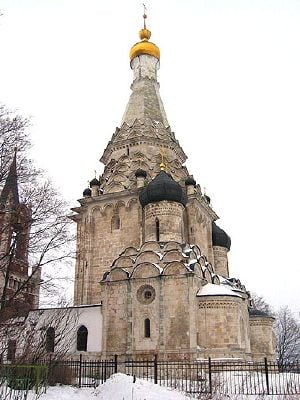
In the sixteenth century, the key development was the introduction of tented roof into brick architecture. Tent-like roof construction is thought to have originated in the Russian North, as it prevented snow from piling up on wooden buildings during long winters. In wooden churches (even modern ones) this type of roof has been very popular. The first ever tent-like church built in brick is the Ascension church of Kolomenskoe (1531), designed to commemorate the birth of Ivan the Terrible.
Seventeenth-century Moscow churches are profusely decorated, but are much smaller. The Patriarch Nikon encouraged building of fairy-like ecclesiastical residences, such as the Rostov Kremlin on the Nero Lake, with five tall churches, innumerable towers, palaces, and chambers. Nikon personally designed his new residence at the New Jerusalem Monastery which was dominated by a rotunda-like cathedral, the first of its type in Russia.
In 1712, Peter I of Russia moved the capital from Moscow to Saint Petersburg, which he planned to design in the Dutch style usually called Petrine baroque. Its major monuments include the Peter and Paul Cathedral, Menshikov Palace, and the Menshikov Tower.
Catherine the Great patronized neoclassical architects invited from Scotland and Italy. Some of the most representative buildings from her reign are the Alexander Palace by Giacomo Quarenghi and the Trinity Cathedral of the Alexander Nevsky Lavra by Ivan Starov. During Catherine's reign, the Russian Gothic Revival style was developed by Vasily Bazhenov and Matvei Kazakov in Moscow.
Alexander I favored the Empire Style, as evidenced by the Kazan Cathedral, the Admiralty, the Bolshoi Theatre, Saint Isaac's Cathedral, and the Narva Triumphal Gates. Later, the nineteenth century saw a revival of traditional Russian architecture. The redevelopment of the center of Moscow saw the Neo-Byzantine construction of the Great Kremlin Palace (1838-1849), the Kremlin Armoury (1844-1851) and the Cathedral of Christ the Saviour (1832-1883), all designed by Konstantin Ton.
Stalinist architecture put a premium on conservative monumentalism. In the 1930s, there was rapid urbanization as a result of Stalin's policies. There was an international competition to build the Palace of the Soviets in Moscow in that decade.
After 1945, the focus was on rebuilding the buildings destroyed in World War II but also erecting new ones: The Seven Sisters in Moscow are seven high-rise buildings built at symbolic points in Moscow. The building of Moscow University (1948-1953) by Lev Rudnev and associates is particularly notable for its use of space. Another notable example is the Exhibition Centre in Moscow, which was built for the second All-Union Agricultural Exhibition (VSKhV) in 1954, that featured a series of pavilions each decorated in the style of the feature that they represent. The other famous examples are the stations of the Moscow Metro and Saint Petersburg Metro's that were built during the 1940s and 1950s are world famous for their extravagant designs and vivid decorations. Stalinist architecture changed the way many post-war cities look, and mostly survive to this day in central avenues and public buildings.
In terms of simpler buildings, the 1960s are mostly remembered for their massive housing plans. A new typical project was developed using nothing but concrete panels to make a simple five-story house. These Pyatietazhki became the most dominant housing constructions. Although rapidly built, the quality was in nothing compared to earlier housing and their almost identical look contributed to the grey and dull stereotype of socialist cities.
As the Soviet Union fell apart many of its projects were put on hold, and some cancelled altogether. However for the first time, there was no longer any control over what theme or how high a building should be. As a result, and with generally improving financial conditions, architecture blossomed in unbelieving rates. For the first time modern methods of skyscraper buildings were implemented and resulted in an ambitious business center being built in Moscow.
Art

Russian icon painting was inherited from the art of the Byzantine churches, and it soon became an offshoot version of the mosaic and fresco traditions. Icon paintings in Russia attempted to help people with their prayers without idolizing the figure in the painting. The most comprehensive collection of Icon art is found at the Tretyakov Gallery in Moscow.
The Russian avant-garde is an umbrella term used to define the large, influential wave of modernist art that flourished in Russia from approximately 1890 to 1930 - although some place its beginning as early as 1850 and its end as late as 1960. The term covers many separate, but inextricably related, art movements that occurred at the time; namely neo-primitivism, suprematism,constructivism, and futurism. Notable artists from this era include El Lissitzky, Kazimir Malevich, Wassily Kandinsky, Vladimir Tatlin, Alexander Rodchenko, and Marc Chagall among others. The Russian avant-garde reached its creative and popular height in the period between the Russian Revolution of 1917 and 1932, at which point the ideas of the avant-garde clashed with the newly emerged state-sponsored direction of Socialist Realism.
During the Russian Revolution, a movement was initiated to put all arts to service of the dictatorship of the proletariat. The instrument for this was created just days before the October Revolution, known as Proletkult, an abbreviation for "Proletarskie kulturno-prosvetitelnye organizatsii" (Proletarian Cultural and Enlightenment Organizations). A prominent theorist of this movement was Alexander Bogdanov. Initially Narkompros (ministry of education), which was also in charge of the arts, supported Proletkult. After Stalin died, Soviet Art went into decline as gradually Russian artists became more independent of the state. In the 1980s, the government ruled that it could not restrict what Russians artists could paint.
Matryoshka dolls
A Matryoshka doll is a Russian nesting doll. A set of Matryoshka dolls consists of a wooden figure which can be pulled apart to reveal another figure of the same sort inside. It has in turn another figure inside, and so on. The number of nested figures is usually six or more. The shape is mostly cylindrical, rounded at the top for the head and tapered towards the bottom. The artistry is in the painting of each doll, which can be extremely elaborate. The theme is usually peasant girls in traditional dress, but can depict almost anything, for instance fairy tales or Soviet leaders.
Cinema
Russian film-making came to prominence during the 1920s, when editing was explored as the primary mode of cinematic expression, resulting in world-renowned films such as The Battleship Potemkin. Because of the depletion of resources during World War I, Russian film schools would take copies of D. W. Griffith's Intolerance and re-cut it as an exercise in creating meaning. This outburst of creativity and innovation was short-lived, however. In the 1930s, Soviet censorship stifled creativity, though it did produce the hit Chapaev. Later Soviet-era filmmakers, most notably Sergei Eisenstein and Andrei Tarkovsky, would become innovative and influential directors.
Since the dissolution of the Soviet Union, Russian cinema has transformed. Although still largely funded by the state, the topics and dynamic have been updated, through exploration of contemporary subjects like sexuality in the 2004 film You, I Love.
"Soviet Cinema" should not be used as a synonym for "Russian Cinema." Although Russian language films predominated, several republics developed lively and unique cinemas, while others did not. Most notable for their republican cinema were Armenia, Georgia, Lithuania, Ukraine, and, to a lesser degree, Belarus and Moldova.
Cuisine
The foundations of Russian cuisine were laid by the peasant food of the rural population in an often harsh climate, with a combination of plentiful fish, poultry, game, mushrooms, berries, and honey. Crops of rye, wheat, barley, and millet provided the ingredients for a plethora of breads, pancakes, cereals, kvass, beer, and vodka. Flavorful soups and stews centered on seasonal or storable produce, fish, and meats. This wholly native food remained the staples for the vast majority of Russians well into the twentieth century. Russia's close proximity to the northern reaches of the ancient Silk Road, the Caucasus, Persia, and the Ottoman Empire has provided an Eastern character to cooking methods.
During the sixteenth to eighteenth centuries, smoked meats and fish, pastry cooking, salads and green vegetables, chocolate, ice cream, wines, and liquor were imported from abroad. At least for the urban aristocracy and provincial gentry, this opened the doors for the creative integration of these new foodstuffs with traditional Russian dishes. The result is extremely varied in technique, seasoning, and combination.
Soups have always played an important role in the Russian meal. The traditional range of soups such as shchi, borscht, ukha, rassolnik, solyanka, botvin, okroshka, and teur was enlarged in the eighteenth to twentieth centuries by both European and Central Asian staples like clear soups, pureed soups, stews, and many others.
In traditional Russian cuisine three basic variations of meat dishes can be highlighted: - large piece of meat boiled in a soup or porridge, and then used as second course or served cold as a snack.
Tea was introduced to Russia from China in the seventeenth century, becoming the most popular national drink. Black tea is by far the most popular type, but since nineteenth century incursions in Central Asia the knowledge and interest in green tea increased. Today Russia remains one of the biggest tea consumers and importers in the world.
Literature
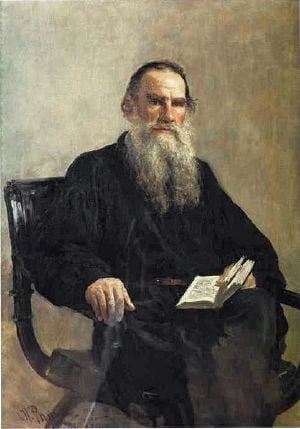
Russia has a rich literary history, beginning with the poet Alexander Pushkin, considered the greatest Russian poet and often described as the "Russian Shakespeare." In the nineteenth century Russian literature underwent an astounding golden age, beginning with the poet Pushkin and culminating in two of the greatest novelists in world literature, Leo Tolstoy and Fyodor Dostoevsky. Significant Russian writers of the Soviet period were Boris Pasternak, Alexander Solzhenitsyn, Vladimir Mayakovski, Mikhail Sholokhov, and the poets Yevgeny Yevtushenko and Andrei Voznesensky. In the field of the novel, Tolstoy and Dostoevsky in particular were titanic figures, and have remained internationally renowned.
Music
Russia is a large and culturally diverse country with dozens of ethnic groups; each with their own forms of folk music. Music in nineteenth century Russia was defined by the tension between classical composer Mikhail Glinka and his followers, who embraced a Russian national identity and added religious and folk elements to their compositions, and the Russian Musical Society led by composers Anton and Nikolay Rubinstein, which was musically conservative. The later Romantic tradition of Tchaikovsky was brought into the twentieth century by Sergei Rachmaninoff.
During the Soviet era, music was highly scrutinized and kept within certain boundaries of content and innovation; notable composers included Stravinsky, Prokofiev, and Shostakovich.
In the 1960s, Vyacheslav Shchurov organized concerts featuring folk singers from across Russia, beginning in 1966. Shchurov thus inspired a wave of singing ethnomusicologists who appeared among the urban intellectuals and recorded rural folk musicians. Perhaps the most important group to follow in Shchurov's wake was the Dmitri Pokrovsky Ensemble. A group of musicians called bards arose at the same time. Generally ignored by the state, bards like Vladimir Vysotsky helped lead a popular return to traditional music.
The same period saw the birth of Russian rock with the band Pojuschie Gitary who created a style called VIA and later released the first Russian rock opera, Orpheus and Eurydice. Other rock bands of the era included Tcvety, Sinyaya Ptica and Golubiye Gitary. By the 1980s, popular folk-oriented groups had arisen. The Cossack Kazachy Krug and Pesen Zemli became most popular. A musical underground (magnitizdat) also arose, where poetic and satirical musicians like Bulat Okudzhava and Vladimir Vysotskiy gained black market fame playing their self played songs.
Many underground rock bands arose during early 1980s in Moscow (Mashina Vremeni, Center), Leningrad (Aquarium, Zoopark), Sverdlovsk (Urfin Dzhyus, Trek) and other cities. They formed active musical communities. During Perestroika they became mainstream, notable bands of that time include DDT, Alisa, Nautilus Pompilius, Kino, Sektor Gaza, Aria. Middle 1990s showed decline for Russian rock due to economical problems, changes in mentality and mass media reorientation.
Heavy metal bands include Aria and its offspring Kipelov, which are the most popular, with new bands genres like Power Metal (Catharsis, Epidemia), Progressive Metal (Orgia Pravednikov, Mechanical Poet), Pagan Metal (Butterfly Temple, Temnozor). An alternative scene arose with bands such as Amatory, Psiheja, 7000$, Jane Air, and Stigmata.
Ballet
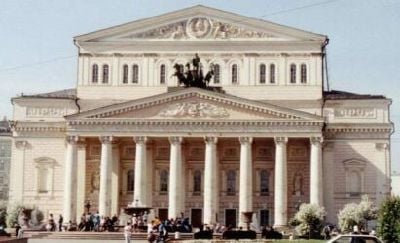
Russia has a revered and recognized tradition of ballet. Russian composer Pyotr Ilyich Tchaikovsky composed the most famous ballets - Swan Lake, The Nutcracker, and Sleeping Beauty. During the early twentieth century, Russian dancers Anna Pavlova and Vaslav Nijinsky rose to fame, and Ballets Russes' travels abroad profoundly influenced the development of dance worldwide for decades to come.
Sports
Russia is a keen sporting country, successful at a number of sports and continuously finishing in the top rankings at the Olympic Games. During the Soviet era the team placed first in the total number of medals won at 14 of its 18 appearances; with these performances, the USSR was the dominant Olympic power of its era. Since the Olympic Games in Helsinki in 1952 and continuing today, the Soviet and later Russian athletes never went below third place in the world, in number and gold medals collected at the Summer Olympics. The 1980 Summer Olympic Games were held in Moscow while the 2014 Winter Olympics will be hosted by Sochi. Among the most played sports are football and ice hockey. Where football is played more as a pastime than professionally, Russia's ice hockey team has a long history of traditions and success, and today more than 70 Russians play in the NHL.
Figure skating is another popular sport; in the 1960s the Soviet Union rose to become a dominant power in figure skating, especially in pairs skating and ice dancing. At every Winter Olympics from 1964 until the present day, a Soviet or Russian pair has won gold, often considered the longest winning streak in modern sports history. Since the end of the Soviet era tennis has grown in popularity and Russia has produced a number of famous tennis players. Chess is a favorite pastime, and a sport that has been dominated by Russians in the post-war (1945-) era. The winner of the 1948 World Chess Championship, Russian Mikhail Botvinnik, started an era of Soviet dominance in the chess world. Until the end of the Soviet Union, there was only one non-Soviet champion. Other sports widely played in Russia include weightlifting, gymnastics, boxing, wrestling, martial arts, volleyball, basketball and skiing.
Notes
- ‚ÜĎ National composition and language proficiency, citizenship Reports "On the Results of the All-Russian Population Census 2010." Retrieved July 19, 2019.
- ‚ÜĎ 2.0 2.1 –ü—Ä–Ķ–ī–≤–į—Ä–ł—ā–Ķ–Ľ—Ć–Ĺ–į—Ź –ĺ—Ü–Ķ–Ĺ–ļ–į —á–ł—Ā–Ľ–Ķ–Ĺ–Ĺ–ĺ—Ā—ā–ł –Ņ–ĺ—Ā—ā–ĺ—Ź–Ĺ–Ĺ–ĺ–≥–ĺ –Ĺ–į—Ā–Ķ–Ľ–Ķ–Ĺ–ł—Ź –Ĺ–į 1 —Ź–Ĺ–≤–į—Ä—Ź 2022 –≥–ĺ–ī–į –ł –≤ —Ā—Ä–Ķ–ī–Ĺ–Ķ–ľ –∑–į 2021 –≥–ĺ–ī (Preliminary estimated population as of 1 January 2022 and on the average for 2021) Russian Federal State Statistics Service. Retrieved June 18, 2022.
- ‚ÜĎ 3.0 3.1 3.2 3.3 World Economic Outlook Database, April 2022 International Monetary Fund. Retrieved June 18, 2022.
- ‚ÜĎ GINI index (World Bank estimate) ‚Äď Russian Federation World Bank. Retrieved June 18, 2022.
ReferencesISBN links support NWE through referral fees
Overall histories
- Riasanovsky, Nicholas V. and Mark D. Steinberg. A History of Russia, 7th ed. Oxford University Press, 2004. ISBN 0195153944
Pre-revolutionary Russia
- Hobsbawm, Eric. The Age of Revolution, 1789‚Äď1848. New York: Vintage, 1996. ISBN 0679772537
- Manning, Roberta. The Crisis of the Old Order in Russia: Gentry and Government. Princeton University Press, 1982. ISBN 978-0691101330
- Moss, Walter G. A History of Russia. Vol. 1: To 1917. Anthem Press, 2003. ISBN 978-1843310235
- Skocpol, Theda. States and Social Revolutions: A Comparative Analysis of France, Russia, and China. Cambridge University Press, 1988. ISBN 0521294991
Soviet era
- Cohen, Stephen F. Rethinking the Soviet Experience: Politics and History since 1917. New York: Oxford University Press, 1985. ISBN 978-0195034684
- Fitzpatrick, Sheila. The Russian Revolution. New York: Oxford University Press, 1982. ISBN 0192802046
- Gregory, Paul R., and Robert C. Stuart. Russian and Soviet economic performance and structure. (The Addison-Wesley series in economics.) Reading, MA: Addison-Wesley, 1998. ISBN 978-0321014276
- Lewin, Moshe. Russian Peasants and Soviet Power. New York: W.W. Norton, 1975. ISBN 978-0393007527
- McCauley, Martin. The Soviet Union 1917‚Äď1991, 2d ed. London: Longman, 1993. ISBN 0582013232
- Moss, Walter G. A History of Russia. Vol. 2: Since 1855. Anthem Press, 2004. ISBN 978-1843310341
- Remington, Thomas. Building Socialism in Bolshevik Russia. Pittsburgh, PA: University of Pittsburgh Press, 1984. ISBN 978-0822938095
- Solzhenitsyn, Aleksandr. The Gulag Archipelago: 1918‚Äď1956. Harper & Row, Publishers, Inc., 1985. ISBN 978-0060154745
Post-Soviet era
- Cohen, Stephen. Failed Crusade: America and the Tragedy of Post-Communist Russia. New York: W.W. Norton, 2000. ISBN 0393322262
- Gregory, Paul R., and Robert C. Stuart. Russian and Soviet Economic Performance and Structure. Prentice Hall, 2000. ISBN 978-0321078162
- Medvedev, Roy. Post-Soviet Russia A Journey Through the Yeltsin Era. Columbia University Press, 2002. ISBN 978-0231106061
- Moss, Walter G. A History of Russia, Vol. 2: Since 1855. Anthem Press, 2004. Chapter 22. ISBN 978-1843310341
External links
All links retrieved December 22, 2022.
- Russia CIA World Fact Book.
- Culture of Russia Countries and Their Cultures.
- Russia BBC Country Profile.
- Russia Profile russiaprofile.org.
- Central Bank of the Russian Federation.
- Sputnik News
| ||||||||||||||||||||||||||
Credits
New World Encyclopedia writers and editors rewrote and completed the Wikipedia article in accordance with New World Encyclopedia standards. This article abides by terms of the Creative Commons CC-by-sa 3.0 License (CC-by-sa), which may be used and disseminated with proper attribution. Credit is due under the terms of this license that can reference both the New World Encyclopedia contributors and the selfless volunteer contributors of the Wikimedia Foundation. To cite this article click here for a list of acceptable citing formats.The history of earlier contributions by wikipedians is accessible to researchers here:
- Russia  history
- Politics_of_Russia  history
- Education_in_Russia  history
- Russian_architecture  history
- Geography_of_Russia  history
- Moscow  history
- Saint_Petersburg  history
- History_of_Russia  history
- Russian_cuisine  history
- Russian_culture  history
- Mikhail_Gorbachev  history
The history of this article since it was imported to New World Encyclopedia:
Note: Some restrictions may apply to use of individual images which are separately licensed.



